

Foodpanda Business Model | How Foodpanda Makes Money

Krishna kumar , Apoorva Bajj
Foodpanda is an online food delivery marketplace that connects users to thousands of local food points. It maintains one of the most prominent apps for ordering from restaurants. Users can browse through various menus and place orders for home delivery/pick-up at the best prices. And it takes just a few clicks. Foodpanda offers you food point menus, customer reviews, and more for over 5,000 restaurants spread across 40+ Indian cities.
So how does Foodpanda make money in the fiercely competitive food-delivery segment? Let's find out by decoding Foodpanda's business model.
Foodpanda was launched in Singapore in March 2012 and expanded to 16 countries by the end of the year. It then expanded to seven more countries and had its presence in 23 countries by February 2013.
The company aimed to reach 40 countries in Asia, Europe, Latin America, the Middle East, and Africa by Q1 2014. Currently, its operations span over 40 countries across continents. A New York Times article said Ralph Wenzel's company Foodpanda is proof that rapid expansion plans are achievable with the right strategies.
Foodpanda Marketing Strategy Foodpanda Business Model Foodpanda Revenue Model Foodpanda - Expenses SWOT Analysis of Foodpanda

Foodpanda Marketing Strategy
Digital marketing plays a huge role in Foodpanda's marketing strategy. The company periodically introduces food festivals, offers, and incentives for its customer base through email marketing.
Foodpanda uses social media platforms to launch its advertisements. It has a Facebook page for regular updates and interactions as well as to maintain visibility and brand value. The company has thousands of followers on Twitter .
Foodpanda is known for its quirky taglines, the latest one being "Take the first bite". And these taglines play a critical role in Foodpanda's promotional campaigns . Foodpanda's promotional programs have been seen on television, and radio, in cinema, in magazines, newspapers, train hoardings, bus hoardings, and in shopping malls.
The company struck a deal with the Indian railways in December 2015. Under this arrangement, it allows travelers to order food online using the Indian railway's platform.

Foodpanda has become immensely popular and this has been possible due to its pricing policies . It has adopted a value-added pricing policy wherein it provides quality food items to customers at a fair price.
Foodpanda's customers are given incentives such as discounts and special offers. This treatment ensures customer retention and allows Foodpanda to stand out in the crowded food delivery segment.
Distribution Network
Foodpanda is owned by Germany-based 'Delivery Hero SE' and lets customers order food from restaurants and other dining places through its website and mobile app. Its network comprises 40+ countries. Foodpanda has partnered with an estimated forty thousand restaurants all over the world.
Foodpanda started in Singapore and was present in Latin American, Eastern European, Russian, African, and Asian countries such as India , Bangladesh, Thailand, Singapore, Malaysia, and Pakistan by the start of 2016.
Foodpanda's distribution network includes more than two thousand partners such as Mast Kalander, Baskin Robbins, Nirula, Subway, and Pizza Hut.
Foodpanda ensures a healthy and delectable eating experience without the hassle of traveling or pre-planning. It connects customers to the restaurants of their choice.
The first step is to locate restaurants that service your area. You do this by selecting your location on Foodpanda's homepage. Once the list of restaurants is displayed, pick a restaurant and go through its menu.
You then choose your meal which gets added to the cart. Once your cart is ready, enter your delivery location and follow the payment instructions. You will then receive an SMS on your order confirmation along with the estimated delivery time.
Foodpanda also lets you see and upload reviews on restaurants. Customers can comment on several features like delivery, sales process, overall impression, and taste.
Foodpanda Business Model
Foodpanda maintains a website and a mobile app that people can use to order food from their favorite restaurants and eateries.
People can search for restaurants that deliver food to their addresses using Foodpanda's website/app. After choosing the restaurant, users can select their meals which are then added to the transaction cart. Once the meals are finalized, people can check out their cart and pay via online payment gateways or through cash-on-delivery.
Once the order is confirmed, a notification goes to the restaurant. Every restaurant that partners with Foodpanda gets access to a 'merchant app'. The restaurant confirms the order and prepares the customer's meal.
As soon as the order is confirmed by the restaurant, a 'delivery signal' is sent to all delivery partners via Foodpanda's 'delivery partner app'. The partner who accepts the request (delivery signal) is entrusted with the responsibility of delivering the customer's food.
The delivery partner arrives at the restaurant to pick up the prepared meal and delivers it to the customer. Customers can track the entire process right from food preparation to delivery on Foodpanda's app/website. Live location tracking is a well-known trend in the food delivery business and Foodpanda offers the same.
Foodpanda Revenue Model
The revenue of Foodpanda is generated through the following means:
Registration Fees Charged From The Restaurant
Foodpanda charges a registration fee from the restaurant to add the latter to its website/app. The restaurant (once added by Foodpanda) becomes visible to customers searching for local restaurants. The registration amount ranges between $100 to $150. It is a one-time fee.
Commission From Restaurant
Foodpanda charges a commission from restaurants on every food order they receive through its platform. The commission is generally between 15% and 25% inclusive of all taxes. The commission is decided considering the restaurant's location, the restaurant's dependence on Foodpanda, and the number and kinds of orders.
- Delivery Fee From Customers
There is a delivery fee for each order that a customer places on the Foodpanda app. Apart from this fee, there are other taxes that customers have to pay.
- Advertisement
Foodpanda is a marketing platform for many restaurants, particularly newcomers. Restaurants can increase their visibility by registering on Foodpanda. They can also pay a certain amount to advertise their brand on the app.
- Affiliate Income
Foodpanda also makes money by offering suggestions on the credit cards of various banks. Moreover, banks send out discounts and special offers on their cards to encourage transactions. Foodpanda collaborates with these banks for affiliate marketing .
Foodpanda - Expenses
- Development and maintenance cost of its online ordering system. The system comprises Foodpanda's website, merchant app, customer app, delivery partner app, and the backend setup for managing everything
- Salaries and provisions for full-time employees
- Salaries and incentives for distribution partners
- Administrative costs
- Customers are given benefits in the form of offers
- Returns and refunds
- Miscellaneous expenses

SWOT Analysis of Foodpanda
Strengths of foodpanda.
- Excellent Platform
Foodpanda is known for its robust and user-friendly website and mobile app . Customers can use these mediums to order meals without any hassle.
They can browse from an extensive list of restaurants. Moreover, customers can track the entire process from placing the order to receiving the delivery.
- Online Ordering
Foodpanda accepts orders through its website and mobile application. It connects customers and restaurants over the Internet.
Foodpanda has raised $749.5 million of venture capital. It raised nearly $20 million in initial funding from Rocket Internet and investment AB Kinnevik in the year 2013. Its last round was a private equity round in the year 2017 where it raised $431.5 million.
During the same year, iMENA Holdings invested approximately $8 million. Foodpanda also received another $20 million in the year 2014. Goldman Sachs also invested approximately $100 million in Foodpanda. It shows how confident investors and VCs are about Foodpanda's success and growth.
Strong Brand Name
Foodpanda was taken over by the firm ' Delivery Hero ' in the year 2016. Delivery Hero manages several international brands. It handles Foodora, HelloFood, Delivery Club, and many others besides Foodpanda. Hence, Foodpanda is under the umbrella of a strong brand.
- Global Operations
Foodpanda has footprints in Eastern Europe, the Middle East, and Asia.
- Global Re-branding
In the year 2017, Foodpanda underwent re-branding with its logo being changed from orange to pink. The iconic panda remains at the forefront of its logo.
- Quick Delivery
Foodpanda is known for facilitating quick deliveries so that customers enjoy piping hot meals.
Great Customer Support
Foodpanda provides excellent customer support . It keeps experimenting with food menus and consistently partners with new restaurants. Therefore, customers can always expect something new from Foodpanda.

Weaknesses of Foodpanda
Orders from nearby restaurants.
Orders are available only from restaurants that are located in the same location as the delivery address. This restricts the customers from trying out various restaurants.
Tap On Free Delivery
The quantity required for free delivery is at times way more than what one asks for or can afford.
Foodpanda doesn't cover most of the cities completely.
Opportunities For Foodpanda
Growing market.
Foodpanda competes in a segment that continues to grow. Hence, there is immense scope for improvement.
Customer Expansion
Foodpanda should tie up with new restaurants and update its website/app to attract foodies.
Threats For Foodpanda
Increasing competition.
The list of startups and established companies that are present in the online food delivery segment is increasing with each passing day.
Changes In Economic Conditions
Economic changes and volatility can crush even the best. Foodpanda needs to build resilience to withstand rough times.
Ease Of Visiting Nearby Restaurants
People at times prefer to go to a nearby restaurant rather than ordering online. This is one of the biggest threats to Foodpanda considering its business model.
Foodpanda is making great strides. The team at Foodpanda is leveraging social media platforms to the fullest to engage customers. It has achieved considerable growth through email marketing, social marketing, and mobile marketing. If Foodpanda continues to innovate and improvise, it won't be long before it dominates the online food ordering and delivery segment.
Frequently Asked Questions
When was foodpanda founded.
Foodpanda was founded in the year 2012.
How does Foodpanda earn money?
Foodpanda earns money in the following ways:
- Registration Fees From the Restaurant
- Commissioned From Restaurant
Why is Foodpanda successful?
Foodpanda is successful because of the following reasons :
- Good Customer Support
Which company owns Foodpanda?
Foodpanda was taken over by the firm 'Delivery Hero' in the year 2016.
How does Foodpanda work?
Users can browse through various menus and place orders for home delivery/pick-up at the best price. And it takes just a few clicks. Foodpanda offers you not only food point menus but customer reviews too.
Must have tools for startups - Recommended by StartupTalky
- Convert Visitors into Leads- SeizeLead
- Payment Gateway- Razorpay
- Spy on your Competitors- Adspyder
- Manage your business smoothly- Google Workspace
The Lexicon Group of Institutes signed an MoU with the National Institute of Securities Markets to Advance Financial Literacy and Skill Development
The Lexicon Group of Institutes has formally entered into a Memorandum of Understanding with the National Institute of Securities Markets (NISM). This MoU signifies a collaborative effort to advance financial literacy, education, and training in the securities market sector. Established in 2006 by the Securities and Exchange Board of India
Top 20 Pharmaceutical Companies in India
India's pharmaceutical industry has come a long way since its early days of producing generic drugs for the world. Today, the country is home to some of the largest and most innovative pharmaceutical companies in the world. According to the Indian Economic Survey 2021, the domestic market is expected to
The Next Level of Fitness at MultiFit, Exclusive ProSkills Masterclasses
April, 2024, Pune- MultiFit, a trailblazer in the fitness industry, hosted a series of one-of-a-kind ProSkills Masterclasses in April, 2024, designed to catapult participants's fitness journey to new heights. Led by industry experts, these immersive workshops offer a unique blend of theory and practical application, equipping participants with specialized skills
Revolutionizing Insurance in India: AI Ushers in a New Era
This article has been contributed by Sanil Basutkar, Co-Founder & Head of Product & Marketing, Bharatsure. The Indian insurance sector has the potential to undergo a significant transformation, driven by the power of AI. For decades, the industry has relied on traditional methods that can be slow, cumbersome, and lack the sophistication
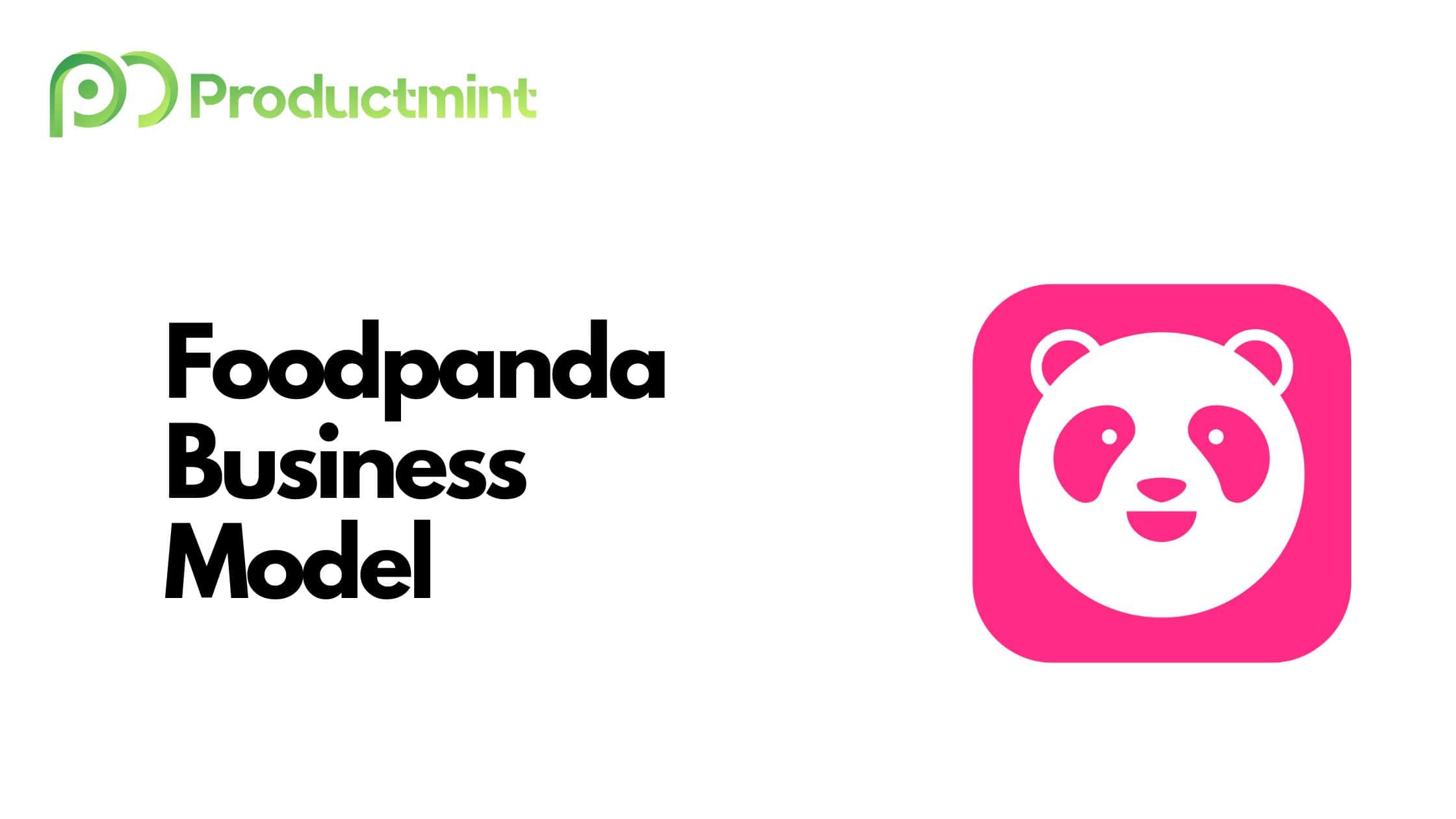
Dissecting The Foodpanda Business Model
Executive Summary:
Foodpanda is an on-demand delivery platform that delivers meals, beverages, groceries, and more. It partners with independent drivers to fulfill orders.
Foodpanda makes money via commissions, delivery fees, subscription fees, as well as grocery sales. The company operates on a marketplace business model.
Founded in 2012, Foodpanda has grown to become one of the world’s largest online delivery platforms. It has raised close to $750 million over the course of its existence.
What Is Foodpanda?
Foodpanda is an online food delivery platform that allows customers to order meals, beverages, or groceries from restaurants and other shops nearby.
The service is available in 13 countries, which are almost exclusively located in Asia (with the exception of Germany).
Foodpanda does not prepare the food themselves. Instead, it works together with local establishments that take advantage of its fleet of drivers.
The drivers themselves are not employed by the platform but work on a contractual basis, meaning they only get paid whenever they complete a job.
Using Foodpanda is as simple as it gets. Customers simply download the app, which is available for Android and iOS, and enter all the relevant information such as their address and payment details.
Then, they simply select and order whatever they would like to eat or drink. The order is then normally delivered within less than 30 minutes.
Foodpanda partners with over 115,000 restaurants while having a total of 80,000 drivers delivering for it.
How Foodpanda Started: Company History
Foodpanda was founded in 2012 by Benjamin Bauer, Christian Mischler, Felix Plog, Kiren Tanna, Ralf Wenzel, Rico Wyder, Rohit Chadda, and Simon Schmincke.
What all of these names have in common is that they’ve worked for startup incubator Rocket Internet at the time.
The Germany-based company, founded by brothers Oliver, Marc, and Alexander Samwer, became known for its copycat model in which it would take proven business ideas and implement them within other regions of the world.
Prominent examples include companies like Zalando , a European e-commerce provider, which was mimicked after Zappos in the United States, or HelloFresh , which had a Swedish predecessor.
Rocket would then go on to either establish these companies as clear market leaders across Europe or sell them for a quick buck. However, around the turn of the decade, Rocket had exhausted much of the European market and began looking for opportunities abroad.
One of those opportunities was spotted in Southeast Asia where it soon began to incubate various businesses. In 2012, it launched Zalora (ironically a copycat of Zalando), Lazada (an eBay-like online marketplace), as well as Foodpanda.
One of Rocket’s key hypotheses was to hire people with exception CVs who had stints at leading banks or consulting firms like Goldman Sachs and McKinsey. These employees would then be placed in the local markets the businesses were based in and given resources, both in the form of funding as well as advice, to build up the business. All of the above-mentioned founders fit the mold of a prototypical Rocket founder.
In April 2012, Foodpanda launched in a variety of (Southeast) Asian markets, including Malaysia, Singapore, and even India. Over the course of the coming year, it added dozens of new markets in an effort to gobble up market share.
Within a year, Foodpanda had managed to partner up with 15,000 restaurants globally while being active in 27 countries. As a result, it successfully raised its first official round of funding from Rocket, Kinnevick, and Russia’s Phenomen Ventures, netting them $20 million.
The money was put to immediate use as Foodpanda acquired Dine, a Singapore-based rival, which marked the firm’s first-ever acquisition. Another acquisition, this time of Brazilian competitor Janamesa (August) as well as a funding round of $8 million (September) capped off a very successful 2013.
2014’s theme was certainly no different. Foodpanda began the year by announcing its third round of funding (in February), which saw the company receive another $20 million from Phenomen Ventures and others.
The platform, furthermore, continued to expand in new countries. It doubled down on Southeast Asia by launching in the Philippines and Hong Kong in June. That same month, it also purchased Delivery Club to strengthen its position in Russia.
Then, two months later, most of its existing investors (plus a few new ones like Falcon Edge Capital) poured another $60 million into the company. Yet again, the funding was used to acquire competitors, this time in Brazil (Entrega Delivery in September) and India (TastyKhana in November).
However, the biggest purchase in the company’s history occurred in February 2015. Foodpanda paid a whopping €80 million to acquire Madrid-based delivery company La Nevera Roja.com. The acquisition was likely informed by two successive funding rounds.
In March and May 2015, Foodpanda raised another $110 million and $100 million respectively. At the time, Foodpanda was present in 40 countries and totaling 580 cities. More than 60,000 restaurants were furthermore part of the platform.
Around the same time, Foodpanda also began to revamp its business model. In the early days, it launched as an aggregator platform where it would simply list available restaurants in the customer’s proximity. The deliveries would then be conducted by the restaurants themselves. Platforms like Grubhub had successfully ridden this model all the way to IPO.
The emergence of smartphones, however, soon led to a shift in consumer expectations. Companies like DoorDash had popularized a new model in which the platform itself would provide the driver supply and therefore allow all kinds of restaurants to offer takeaway options.
After pouring hundreds of millions into expansion, Foodpanda vis-à-vis Rocket Internet soon realized that scaling this model in a profitable manner across the world would prove extremely costly. By the end of 2015, the company began to divest from a variety of markets.
For instance, in December, it shut its doors in Vietnam. That same month, it laid off 300 employees (equal to 15 percent of its workforce) from its Indian business. In February 2016, Foodpanda sold various businesses in Spain (including La Nevera Roja), Italy, Brazil, and Mexico for €125 million in cash to London-based competitor Just Eat .
Nevertheless, in the markets that it deemed important, Foodpanda continued to pour money in. In March 2016, it acquired the operations of delivery.com in Hong Kong for an undisclosed sum. In both Hong Kong as well as Singapore it began facing additional pressure from the likes of Deliveroo and Uber Eats.
Foodpanda, furthermore, expanded its offering beyond just food delivery. For example, it launched a corporate food delivery service for business clients. Because of its continued focus on profitability, it also sold off its Indonesian business in August where Grab and Gojek had been dominating food delivery.
Eventually, in December, the company had to finally give in to the consolidation that was sweeping across the global food delivery market. Delivery Hero, now one of the world’s biggest online delivery companies and heavily backed by Rocket as well, purchased Foodpanda for $500 million.
Both Delivery Hero and Foodpanda were headquartered in Berlin, thus allowing for easier integration between the two. Furthermore, Rocket, which had become a public company two years prior, had seen investors question the legitimacy of its investments. Therefore, the startup incubator likely pushed the two companies to merge to further boost profitability.
In May 2017, Foodpanda vis-à-vis Delivery Hero raised $431.45 million from Naspers (which had become renowned for its early investment in Alibaba) to continue fueling its growth plans.
Regardless of the additional capital, profitability was still a big theme. As such, Foodpanda sold off its Indian business to ride-hailing platform Ola in December 2017. It could simply not sustain competing against bigger and local players like Swiggy and Zomato.
Over the coming years, Foodpanda continued to double down on the markets it remained competitive in. In August 2019, it moved its headquarters to Singapore (from Berlin) to remain close to its best-performing markets.
More importantly, Foodpanda also expanded its product line from restaurant deliveries towards grocery and everyday-item delivery through its pandamart brand.
Across 2020, Foodpanda’s business was propelled to new heights altogether. The coronavirus pandemic led to the worldwide closure of dine-in options, thus forcing customers to order their meals through various apps. As a result, the company was able to grow revenues almost threefold.
Moreover, the pandemic allowed Foodpanda to expand into new markets again. In September 2020, the platform launched in Japan. Months prior, despite political unrest, it had also expanded into Myanmar.
Its commitment to the (Southeast) Asian region was exemplified through the opening of a new tech hub in Taiwan in May 2021, which is intended to expand and diversify its local talent pool.
However, the biggest news likely came a few months later in the summer of 2021. Delivery Hero decided to re-enter the German market again. Just Eat’s Lieferando had been roaming freely for close to three years (after Delivery Hero sold off its existing businesses there).
It would launch in Germany under the Foodpanda brand, which would be its first presence outside of Asia. In September 2021, Delivery Hero also rebranded its previous acquisition NetPincer into Foodpanda, giving it a second presence in Europe (Hungary, more precisely).
How Does Foodpanda Make Money?
Foodpanda makes money via (restaurant) commissions, delivery fees, subscription fees, as well as grocery sales.
Foodpanda operates on a marketplace business model where it matches supply (here: mainly riders and restaurants) with existing demand. The platform then handles aspects such as payment processing, delivery, as well as product sorting to maximize orders.
Let’s take a closer look at each of its revenue streams in the section below.
Commissions
The bulk of the revenue that Foodpanda generates comes from the commissions that it charges restaurants.
Normally, the platform charges anywhere between 25 percent to 30 percent for an order. If a customer orders food worth $10, then Foodpanda gets to keep around $3.
In return, restaurants get to take advantage of the platform’s delivery fleet, which allows them to serve a greater number of customers. Second, Foodpanda’s app is accessed by millions of people, thus providing restaurants with almost immediate demand.
Also, restaurants don’t have to bother with money collection as the funds are stored within their respective accounts.
However, it must be noted that the above rate does not apply to every partner. Worldwide renowned chains like KFC can likely command much lower rates as a result of their branding power.
Foodpanda, in return, benefits from a substantial increase in demand as these restaurant chains provide brand recognition as well as added trust.
The same, in all likeliness, applies to its partners on the grocery side where Foodpanda works together with brands like 7-Eleven.
Delivery Fees
The second driver of revenue is the delivery fees that customers pay whenever they order something.
Delivery fees vary depending on the market itself (order food in Singapore is much more expensive than in Thailand) as well as the customer’s proximity to the restaurant.
In most cases, delivery fees simply cover the cost of the driver who gets paid for completing the order.
In the past, Foodpanda drivers in Malaysia and Thailand (amongst others) have protested due to a decrease in pay. Unfortunately, given the lack of opportunity, these protests did not lead to a change in legislation.
Apart from the food and grocery delivery, Foodpanda has also introduced pandago, which allows businesses to use its rider fleet for their own deliveries. Given that Foodpanda does not benefit from commissions, its delivery fee for pandago is substantially higher.
Subscriptions
In 2021, Foodpanda introduced a premium subscription service that grants customers access to a variety of benefits.
Customers pay a monthly fee, which varies depending on the country of residence. In exchange, they can take advantage of various benefits, which include a limited number of free deliveries, various discounts, as well as access to exclusive offers.
Customers, however, are not the only ones profiting. Offering subscriptions likely increases their desire to order repeatedly, which in turn drives revenue and customer loyalty for Foodpanda.
Grocery Sales
Over the course of 2019 and 2020, Foodpanda has introduced its very own grocery delivery service called pandamart .
Customers can order thousands of daily essentials, including groceries, fresh produce, household essentials, and more, directly from Foodpanda.
The company thus operates its own localized warehouses in which it stores the products. As such, Foodpanda generates revenue through the sale of those products.
Moreover, much like its American and European counterparts Gopuff or Getir , it can be assumed that Foodpanda is marking up prices, thus leading to increased profitability.
Foodpanda Funding, Revenue & Valuation
According to Crunchbase, Foodpanda has raised a total of $749.5 million across eight rounds of venture capital funding.
Notable investors include Delivery Hero, Rocket Internet, Falcon Capital, Kinnevik, Goldman Sachs, and many others.
The last time Foodpanda’s valuation has been disclosed was during the firm’s acquisition by Delivery Hero, which paid $500 million.
Delivery Hero currently does not disclose detailed revenue figures for Foodpanda. However, its mother company did generate $766 million in revenue for Asia, which includes Foodpanda as well as Woowa Brothers.
Who Owns Foodpanda?
Foodpanda is wholly owned by Delivery Hero SE, a Berlin-based multinational food delivery service that operates in 50 countries across the globe.
Delivery Hero acquired Foodpanda back in December 2016 for $500 million in cash. The platform’s previous majority owner was Rocket Internet.

Viktor Hendelmann
Hi folks, Viktor checking in! Years of experience in various tech-related roles have led me to start this blog, which I hope provides you with as much enjoyment to read as I have writing the content.
About productmint
productmint.com provides tailored content on all things business and tech. The site arose from my fascination with how modern-day businesses utilize technology and product-led thinking to become dominant players in their industry.
Business Product Privacy Policy Terms of Service
Follow productmint
Facebook LinkedIn Twitter Buy me a coffee
Last Updated on December 23, 2022 by Viktor Hendelmann
About Supliful
Supliful is dropshipping platform that lets you launch an online consumer brand with no upfront cost or risks.
You can choose from 100+ white label products and launch your brand as soon as today

Search white-label product supliers
Discover 100s of white label products ready to be customised and sold in your online store
Explaining the Foodpanda Business Model Canvas
Foodpanda, an app-based on-demand food delivery service, has transformed the way people across the globe order food. with a simple swipe, users can browse local restaurants and have their favorite meals delivered straight to their doorstep..
The following article will explore the Foodpanda business model canvas in great detail, discussing key aspects such as its value proposition, core components, partnerships, and target customer segments. So, buckle up and let's explore how Foodpanda successfully brings both convenience and variety to millions of users.
Detailed Explanation on the Foodpanda Business Model Canvas
Foodpanda is an online food delivery platform that connects customers with a wide range of restaurants and food establishments. The business model canvas is a strategic tool used to analyze and plan the various components of a business model. Here is an explanation of the key elements of the Foodpanda business model canvas:
- Customer Segments: Foodpanda targets two main customer segments: consumers who want to order food online for home delivery and restaurants that want to expand their customer base and offer delivery services.
- Value Proposition: The value proposition of Foodpanda is to provide a convenient and efficient way for customers to order food online and have it delivered to their doorstep. For restaurants, Foodpanda provides an opportunity to increase their sales by offering delivery services and reaching a wider customer base.
- Channels: Foodpanda operates through a website and mobile app that allows customers to browse menus, place orders, and track their deliveries. Additionally, Foodpanda uses various marketing channels such as social media and email marketing to reach its customers.
- Customer Relationships: Foodpanda has a customer-centric approach and focuses on providing excellent customer service. This is achieved through various initiatives such as 24/7 customer support, user-friendly interfaces, and fast delivery times.
- Revenue Streams: Foodpanda earns revenue by charging a commission fee on each order placed through its platform. The commission fee is typically a percentage of the total order value and varies based on the agreement with each restaurant partner.
- Key Resources: Foodpanda's key resources include its technology platform, its network of restaurant partners, and its customer support team. Additionally, Foodpanda relies on its brand reputation and marketing efforts to attract new customers and partners.
- Key Activities: Foodpanda's key activities include building and maintaining its technology platform, partnering with restaurants, and providing customer support. Additionally, Foodpanda continually seeks to expand its customer base and restaurant network.
- Key Partnerships: Foodpanda partners with restaurants to offer their menu items on its platform and facilitate food delivery. Additionally, Foodpanda may partner with other companies such as payment gateways and logistics providers to enhance its services.
- Cost Structure: Foodpanda's costs include technology development and maintenance, employee salaries, marketing expenses, and logistics costs associated with food delivery. The cost structure varies based on factors such as the size of the business, the number of restaurant partners, and the level of marketing and advertising expenses.
Understanding the Foodpanda Business Model
The Foodpanda business model is built on the foundation of connecting hungry customers with nearby restaurants and delivery partners. As a platform company, Foodpanda focuses on three core aspects: customers, restaurants, and delivery partners. To better understand this business model, let's delve into its origins and core components, as well as its primary revenue streams and monetization strategies. If you are interested in Mc'Donalds busines model, this is for you!
The Origins of Foodpanda
Foodpanda was founded in 2012 by Ralf Wenzel, Benjamin Bauer, Rohit Chadda, and Felix Plog as part of Rocket Internet's network of startups. The idea behind the company was to provide a convenient and reliable platform for customers to order food from their favorite restaurants and have it delivered to their doorstep.
Initially, Foodpanda targeted the Asian market and expanded rapidly across various countries. It quickly gained popularity among customers and restaurants alike, thanks to its user-friendly mobile app and efficient delivery system.
As the demand for online food delivery grew, Foodpanda continued to expand its operations, partnering with more restaurants and delivery partners. Today, Foodpanda operates in over 40 countries, with a vast network of partner restaurants and delivery personnel.
Its success in the industry has made it one of the leading players in the online food delivery market.
Core Components of the Foodpanda's Business Model
Foodpanda's success can be attributed to its focus on core components that contribute to its growth and profitability. Key elements of its business model include:
- User-friendly mobile app: Foodpanda's mobile app is designed to provide a seamless experience for customers. It offers a wide range of food options, easy payment options, and real-time tracking of orders.
- Partner restaurants: Foodpanda partners with a diverse range of restaurants, offering customers a wide variety of food options to choose from.
- Efficient delivery system: Foodpanda's delivery system is designed to ensure timely and reliable delivery of food to customers. It partners with delivery partners who are trained to handle food with care and deliver it to customers' doorsteps.
- Multiple payment options: Foodpanda offers multiple payment options, including cash on delivery, credit/debit card payments, and mobile wallet payments, to provide customers with flexibility and convenience.
- Robust customer support system: Foodpanda has a dedicated customer support team that is available 24/7 to address any queries or concerns that customers may have.
These factors work together to create a seamless experience for customers and ensure that Foodpanda remains at the forefront of the industry.
Revenue Streams and Monetization
Foodpanda generates revenue through various channels, primarily through commissions it charges partner restaurants on each order placed through its platform. These commissions range from 10% to 30%, depending on the region and restaurant agreements.
Additionally, Foodpanda earns revenue from delivery fees paid by customers, as well as advertisements and promotions on its app. The diversified revenue streams ensure a stable flow of income while minimizing reliance on any single source.
In conclusion, the Foodpanda business model is built on the foundation of providing a seamless experience for customers, while partnering with restaurants and delivery partners to ensure timely and reliable delivery of food.
Its success in the industry can be attributed to its focus on core components, diversified revenue streams, and commitment to customer satisfaction.
Foodpanda's Value Proposition
The food delivery industry has seen a major shift in recent years, with more and more people opting for the convenience of ordering food online.
Foodpanda is one of the leading players in this space, offering a value proposition that focuses on convenience for customers, expanding options for restaurants, and streamlining the delivery process. Let's take a closer look at these three core aspects of its business model.
Convenience for Customers
Foodpanda's user-friendly app interface makes it easy for customers to order food from the comfort of their homes or offices. With just a few taps, customers can browse through a wide range of cuisines and restaurants, select their favorite dishes, and place an order.
This eliminates the need for traditional phone ordering or physically visiting a restaurant, saving time and effort. What's more, Foodpanda offers multiple payment options, including cash on delivery and digital payments, so customers can choose what works best for them.
Foodpanda also offers a range of features that enhance the customer experience. For instance, customers can track their orders in real-time, so they know exactly when their food will arrive. They can also leave feedback and ratings for restaurants, helping other customers make informed decisions.
Expanding Options for Restaurants
Partnering with Foodpanda provides restaurants with an opportunity to reach a wider audience and increase their sales. By joining the platform, restaurants can benefit from increased visibility, access to a larger customer base, and opportunities to grow their businesses.
Foodpanda also offers support with online menu optimization and targeted promotion campaigns, helping restaurants maximize their potential.
Foodpanda's restaurant partners also benefit from its advanced analytics and insights. By analyzing customer data, Foodpanda helps restaurants understand their customers better and make data-driven decisions about their menus and pricing strategies.
Streamlined Delivery Process
Foodpanda's delivery operations are designed for high efficiency, with delivery partners assigned to specific zones or areas. This ensures faster delivery times and a better customer experience.
The company continuously optimizes its routing algorithms and streamlines processes for its delivery partners, improving overall performance and customer satisfaction.
Foodpanda's delivery partners are equipped with state-of-the-art technology that helps them navigate through traffic and find the most efficient routes.
They are also trained to provide excellent customer service, ensuring that customers receive their orders in a timely and professional manner.
In conclusion, Foodpanda's value proposition is built around convenience, choice, and efficiency. By focusing on these core aspects, the company has been able to establish itself as a leader in the food delivery industry, providing customers with a seamless and enjoyable experience, while helping restaurants grow their businesses and reach new customers.
Key Partners and Resources
The Foodpanda business model relies on strong partnerships and resources to fuel its growth and maintain competitiveness. It collaborates with an extensive network of restaurants and delivery partners, leveraging technology and data to enhance its offering to customers.
Partnering with Restaurants
Foodpanda seeks out popular and high-quality restaurants to join its platform, offering them a cost-effective way to boost sales and gain more customers.
By maintaining a diverse range of food options, Foodpanda attracts a larger user base that benefits not only the platform but also the partner restaurants.
The company also provides assistance with menu setup, order management, and targeted marketing campaigns to boost partner restaurant performance.
Foodpanda's partnership with restaurants is a win-win situation for both parties. Restaurants are able to expand their customer base without incurring additional marketing costs, while Foodpanda is able to offer a wider variety of food options to its customers.
This partnership also allows Foodpanda to maintain a high level of quality control over the food that is being delivered to its customers.
Collaborating with Delivery Partners
Delivery partners are a crucial part of the Foodpanda ecosystem. They facilitate the swift delivery of meals and ensure customer satisfaction.
Foodpanda manages an extensive network of freelance delivery personnel, offering them a flexible work arrangement and performance-based incentives. As a result, the company motivates its delivery partners to provide fast and efficient services that meet customer expectations.
Foodpanda's delivery partners are the backbone of its business. They are responsible for ensuring that food is delivered to customers in a timely and professional manner.
By providing a flexible work arrangement and performance-based incentives, Foodpanda is able to attract and retain top-quality delivery partners who are committed to providing excellent service to customers.
Leveraging Technology and Data
Foodpanda utilizes cutting-edge technology to enhance its user experience, streamline processes, and optimize delivery routes. It leverages data to understand customer preferences and offer personalized recommendations, driving higher engagement and repeat orders.
The company also invests in advanced analytics to monitor platform performance, identify growth opportunities, and make data-driven decisions for continuous improvement.
Technology and data are at the heart of Foodpanda's business model. By leveraging technology, the company is able to provide a seamless user experience from ordering to delivery.
Data analysis allows Foodpanda to better understand its customers and provide personalized recommendations, resulting in higher engagement and repeat orders. Additionally, the company's investment in advanced analytics allows it to make data-driven decisions that drive continuous improvement and growth.
Customer Segments and Channels
Foodpanda's customer-centric approach focuses on targeting specific segments and catering to diverse tastes and preferences. By recognizing the importance of efficient marketing channels, Foodpanda ensures that it remains top-of-mind for its target audience.
Targeting Urban Dwellers
Foodpanda's primary target audience comprises urban dwellers who seek convenience and variety when it comes to dining options. Busy professionals, students, families, and individuals who prefer ordering food instead of cooking are among Foodpanda's core customer segments.
The platform addresses their needs by offering an extensive range of food choices and quick deliveries, providing convenience and a superior customer experience.
Urban dwellers often have hectic schedules and limited time for meal preparation, making Foodpanda an ideal solution for their dining needs.
The platform's user-friendly interface and easy-to-use mobile app allow customers to quickly and easily place orders, track deliveries, and make payments. Foodpanda's commitment to customer satisfaction has helped it build a loyal user base and establish itself as a leading player in the food delivery industry.
Catering to Diverse Tastes and Preferences
One of the key strengths of Foodpanda lies in its ability to offer a wide variety of cuisines and dishes that cater to the diverse tastes and preferences of its customers.
From fast-food chains to local eateries and gourmet restaurants, the platform ensures that there is something for everyone, regardless of their preferred food choices or dietary restrictions.
This focus on diversity enables Foodpanda to satisfy the needs of its customers and maintain a loyal user base.
Foodpanda's commitment to diversity extends beyond its food offerings. The platform also partners with local restaurants and businesses to support the communities in which it operates. B
/\y working with small businesses and independent restaurants, Foodpanda helps to promote local culture and cuisine while providing customers with unique and authentic dining experiences.
Utilizing Multiple Marketing Channels
Foodpanda employs various marketing channels to reach potential customers and promote its services. From traditional advertising and public relations campaigns to digital channels such as social media, email, and targeted promotions, the company capitalizes on multiple touchpoints to increase brand visibility and attract new customers.
By continually monitoring the performance of its marketing campaigns, Foodpanda can make data-driven decisions and optimize its marketing efforts to maximize impact.
Foodpanda's marketing strategy also includes partnerships with popular food bloggers and influencers, who help to promote the platform to their followers and drive engagement.
By leveraging the power of social media and influencer marketing, Foodpanda is able to reach a wider audience and increase brand awareness in a cost-effective manner.
In conclusion, Foodpanda's business model canvas combines a strong value proposition, strategic partnerships, and a focus on customer needs to create a successful and sustainable platform that revolutionizes the food delivery industry.
As technology continues to advance and evolve, Foodpanda's ability to adapt and innovate will ensure its continued growth and relevance in the competitive world of on-demand food delivery.
Are you in search of additional wisdom and knowledge?
don't miss out on these valuable articles about business models:
- supliful.com/blog/waycool-business-model-canvas-explained
- supliful.com/blog/dyson-business-model-canvas-explained
- supliful.com/blog/loreal-business-model-canvas-explained
By delving into these posts, you'll gain a deeper perspective on different business models, enabling you to enhance your skills.

Suggested posts

How to Market a Product Online for Free in 2024
Are you ready to take your business to the next level in 2024? In today's digital age, online marketing has become a powerful tool for businesses of all sizes. By effectively utilizing online marketing strategies, you can reach a wider audience and increase your brand visibility without breaking the bank.

How To Sell L-Carnitine Online Without Inventory
Due to the rise of e-commerce, it’s now easier than ever to sell products online without maintaining a physical inventory. This means that you can start an online business quickly and easily, without having to worry about keeping products in stock.

How to price your Supliful products to drive sales and profit
How to price products is a tough question to answer, regardless of whether you're a first-time entrepreneur or a founder with several ventures under your belt.

- How it works
- Help center
- Get label or store design Roadmap
- Liability insurance
- Terms of Use
- Privacy Policy IP policy
- Returns Social Responsibility
- Affiliate program

- Request Demo
- Get Free Consultation
Foodpanda Business Model: Check Everything to Have Insight into its Working & Revenue Model
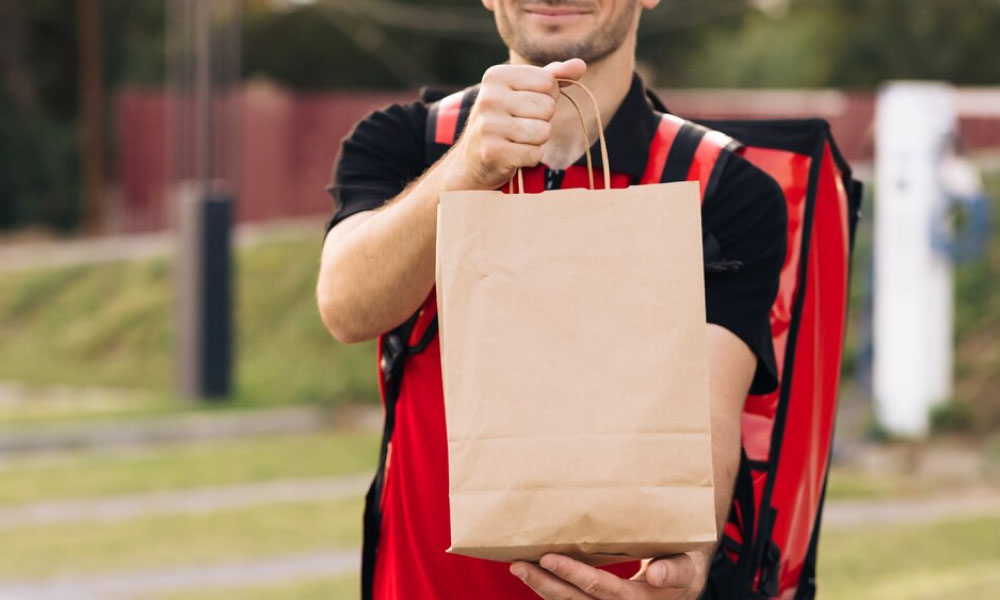
With the growing popularity of the Uber business model , an on-demand app idea got validation and became trendy after that. Foodpanda is one such on-demand food ordering and delivery platform that has gained massive popularity in the market. It’s an advanced system that delivers food to customers’ doors from nearby restaurants. Check the Foodpanda business model to have insight into its working and revenue strategy.
Businesses wonder about the Foodpanda business model; they are surrounded by many questions like how the platform works. How does it generate money? And many more. Then go through the article to learn everything and have deep insight into each detail about the food ordering and delivery platform.
Now, most businesses opt for an on-demand app solution helping them cater to the growing needs of the market. Food apps in the on-demand economy have a simple psychological appeal; they promise to save the end user’s time and effort. Revenue in the food delivery segment is estimated to grow and reach around US$1.02tn in 2024.
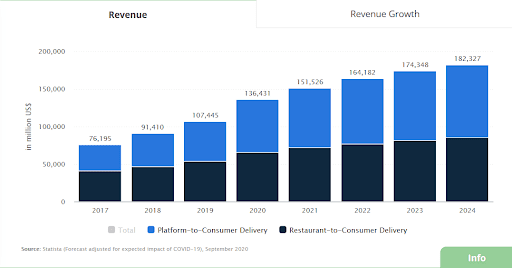
On-demand apps like Foodpanda promise to save our time and efforts to a great extent. The on-demand platform delivers convenience just as a simple attribute; it provides comfort across customer touchpoints. Let’s explore more about the food business giant Foodpanda to gain deep insight into its business and revenue model.
What is Foodpanda?
Foodpanda is a food ordering and delivery platform that connects users with local restaurants. Easy-to-use platforms enable users to browse various menus and place orders to deliver the best price. Food lovers can order a wide variety of mouth-watering and delicious food online with a few clicks on their smart devices.
Foodpanda Timeline: Have a Quick Look Over the Success History of Food Business Giants!
Foodpanda is a food delivery marketplace that operates in more than 50 countries. It is active in Bulgaria, Asia Pacific, and Romania; the platform is owned by a Berlin-based company named Delivery Hero SE and headquartered in Berlin, Germany. The platform enables food lovers to order their favorite and mouth-watering dishes from local restaurants.
Foodpanda has partnered with more than 115,000 restaurants in about 246 cities. It has worked with 80,000 delivery riders; Delivery Hero acquired the company in December 2016. While in India, Foodpanda’s business was acquired by cab aggregator Ola on 29 December 2017 for an undisclosed amount of $40-$50 million.
The company sold its Delivery Club business in 2016 in Russia tomail.ru for $100 million. In the same, Foodpanda’s largest investor, Rocket Internet, sold Foodpanda to German competitor Delivery Hero. In 2017, Foodpanda rebranded from Orange to Pink with an updated logo; tech giant Delivery Hero followed the rebranding.
The company started offering unique discounts and offers to increase platform traffic; in 2018, it completed around 3 Lakh daily orders. This number increased to 5,000 daily orders in 2019. Ola suspended the Foodpanda food delivery business in 2019 and fired more than 1,500 “food delivery executives.”
The Foodpanda brand continues in-house brands, also known as “cloud kitchens.” The concept was adopted by the company when it acquired Holachef in 2018. However, in 2019 the company will have only three private label brands under its cloud kitchen business, including the Great Khichd experiment and FLRT.
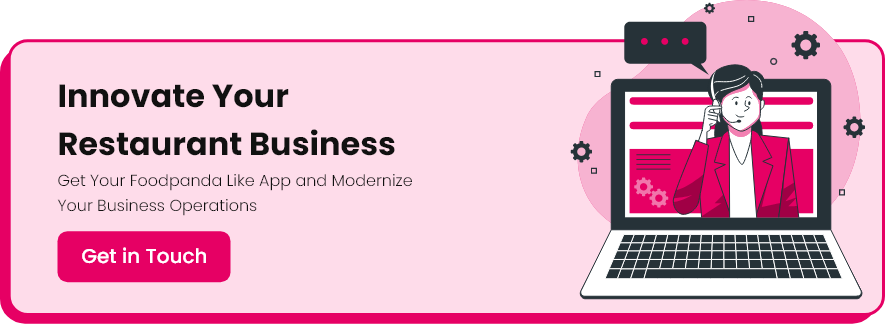
Explore the Funding History of Foodpanda to Know Everything About its Partners & Investors
Foodpanda raised a total of $318 million in venture capital; the company raised 20 million in initial funding from Investment Rocket Internet, AB Kinnevik, and Phenomen Ventures in 2013. iMENA Holdings invested around $8 Million in the same year; in 2014, the company raised $20 million from investors and Phenomen Ventures.
Later Foodpanda announced that it had raised $60 million in financing from different groups of investors. In 2015, Foodpanda announced it had raised more than $110 million from Rocket Internet and other investors. And within a two-month time interval, Goldman Sachs and other investors invested over $100 Million in Foodpanda.
Some Interesting Facts & Figures About Foodpanda Business and Revenue Model
Founders: Lukas Nagel and Rico Wyder Founded: in 2012 Headquarters: Berlin, Germany. Foodpanda Valuation: $6 billion+ Foodpanda Funding: $100 Million from Rocket Internet and other investors.
Statista’s report shows that Foodpanda received around 8.7 million in 2014 alone, while it had completed about 22.6 million in 2015.

How Does Foodpanda Work
Foodpanda is an impressive platform that helps eateries to offer excellent service to a wide range of customers who want to get their food delivered to their doorsteps. The company generates profit through delivery fees; it decreases its operational cost by following some effective methods:
- Offer discounts for bulk purchases
- Build a higher network to deliver food on time
- Collecting cash before delivery
- Advertisement fees
- Offer different types of deliveries besides food delivery.
Foodpanda can gain massive popularity in the market by focusing on all the terms listed above. The on-demand app is increasing and has grabbed the tremendous limelight in the past few years. Hence, more businesses are considering investing in the on-demand solution; they are stepping into developing a feature-rich Foodpanda clone app for their business, helping them deliver a seamless delivery experience to food lovers. Have a quick look to know how Foodpanda works to ensure prompt delivery to the customer’s doorsteps.
Step 1: Food lovers explore the list of nearby restaurants and menus to order mouth-watering dishes from them. Step 2: Restaurants receive an order and prepare food Step 3: Prepared order is handed over to delivery providers Step 4: The delivery provider delivers the meals to the customer’s place Step 5: Customers make payments and provide feedback according to their experience gained.
The simple and effective working of the Foodbanda makes it the best choice for food lovers and eateries. You can also invest in an app similar to Foodpanda to boost your business growth for a long time.
Foodpanda Business Model Canvas
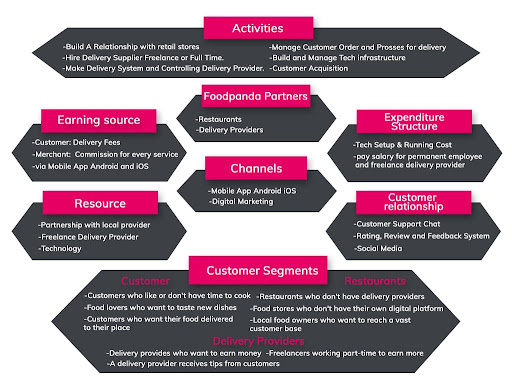
Foodpanda ensures to deliver a tasty, healthy, and unique experience to eating to food loves. It has successfully eliminated the need to travel to restaurants as food lovers can get their food delivered right at their place. It’s all about ordering online; the platform connects restaurants with a restaurant of their choice. Learn everything to know how the platform works, what the business model consists of, and much more right away.
Customer Segments
Foodpanda ensures to deliver a tasty, healthy, and unique experience to eating food lovers. It has successfully eliminated the need to travel to restaurants, as food lovers can get their food delivered right to their place. It’s all about ordering online; the platform connects restaurants with a restaurant of their choice. Learn everything to know how the platform works, what the business model consists of, and much more right away.
- Restaurants
- Delivery Providers
Value Proposition
The platform offers primary value propositions, including convenience, accessibility, customization, brand status, and cost reduction. Foodpanda creates accessibility by allowing food stores to market their business to customers who don’t want to visit a physical location and find difficulty searching the website online.
It enables customers to place an order from an advanced solution, ensuring to offer convenience; they can place orders 24*7 without any hassle through the platform. Customers are also provided with picking up orders or getting them delivered to their place; they can pay with any payment method at their convenience.
The platform enables customization by enabling customers to filter restaurants as per different types. It offers numerous engaging deals to customers, like meal discounts, free deliveries, etc. The fantastic offers increase customer engagement with the platform by enabling them to try new offerings and save their money.
Foodpanda has developed a strong brand because of its business success; presently, it is successfully operating in about 500 cities in 24 countries. An online ordering and delivery platform has also won some great countries, like the European Tech Startup Award in 2014 for “Best E-commerce Startup.”
Cost Structure
Foodpanda has a cost-driven structure that mainly aims to minimize expenses, surge store sales, and significant automation. The biggest cost drivers for the platform are sales/marketing and fixed costs. Some other major drivers include customer support, administration, and also fixed expenses.
Your Competitors are Online, Are You?
Empower Your Food Business
Explore More
How Does Foodpanda Make Money: Have Deep Insight into Revenue Stream
Foodpanda’s most immense amount of revenue mainly comes from restaurant commissions with which the platform has partnered. The report shows that the platform earns more than 40% of revenue from the delivery business, while 10% profit from ads. There are many other ways through which Foodpanda generates revenue; explore to know how it creates money.
Registration Fees:
Digitalization has increased the craze of getting food delivered right to their doorsteps. Rather than restaurants and cravings nowadays, food lovers love to leverage the custom home delivery facility. Foodpanda eliminates extra initiatives to manage and find delivery services. Foodpanda changes approximately $100 to $150 for the registration.
Advertisement:
Foodpanda charges advertisement fees from brands. It enables restaurants to advertise their business on the platform.
Delivery Charges:
Foodpanda charges fees on every delivered order; delivery charge cost entirely depends on delivery location.
Suggesting:
When users open the Foodpanda app or website, they come across the bands, credit, debit, and other payment methods. The platform charges some amount from banks and companies for suggesting them to customers; this is an affiliate income source for Foodpanda.
Commission:
Foodpanda claims around 20% commission on every order that customers place through the platform. Besides commission, restaurants don’t need to pay the place rent, electricity bills, and other service costs; this ensures great profit-making for the platform.
Ending Note
Undoubtedly Foodpanda has faced numerous ups and downs throughout its business journey, but the food giant successfully ensures its survival. The immense growth is an outcome of an increase in preferences for online services. Moreover, the Foodpanda like app platform offers a seamless experience to customers by enabling them to get their favorite dishes delivered to their doorsteps. It has captured a vast base in the online marketplace and is here to stay for a longer time. You can also develop an advanced delivery platform for your business.

Nirav Parmar
Having More than three years of experience, Nirav is an outreach expert at Elluminati. Having a keen interest in communication, content, and digital marketing, he has worked with many brands and helped entrepreneurs to establish an online presence that drives their business forward.
You Might Also Like

How to Start a Limo Business Online in 2024?

Walmart Business Model: Facilitating Everyday Shopping Deals

How Talabat Works? Talabat Business Model and Revenue Channels Explained

How Onnow Works? Onnow Business Model Explained
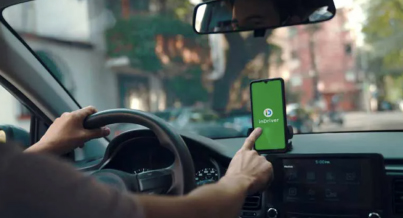
How inDriver Works: Business Model And Revenue Insights

How does KuCoin Works: Explore Kucoin Business and Revenue Model
Want to build a high-tech product? Check what we can do for you.

Foodpanda Business Model: How Foodpanda Works & Makes Money
Foodpanda business model: how foodpanda works & makes money.
Online food delivery platform, Foodpanda connects users to thousands of local meal ordering and delivery points. The hyperlocal delivery-based business model helps the delivery giant to cater to the growing demand in the market. Looking at the business giant’s success, many delivery brands are interested in a Foodpanda business model; they are trying to know how the delivery platform works and makes money.
The food delivery giant has covered a long journey. We are serving the communities in more than 400 cities and more than 12 markets in Asia, and the company hopes to play a positive part in customers’ lives.
Foodpanda is Asia’s largest delivery platform that helps 3000 new retailers and stores. The SMEs’ digitization made them experience 430% of growth. It is the most used platform for ordering meals from restaurants.
Users can explore multiple options before placing the order; they can even choose between pick-up or home delivery at their convenience. It takes only a few minutes for customers to place an order; Foodpanda offers customer ratings, menus, and other details for over 12 countries and over 115000+ restaurants.
What is Foodpanda?
Owned by Delivery Hero, Foodpanda is an on-demand food and grocery delivery platform. The company operates as a lead brand that is headquartered in Singapore and works for Delivery Hero in Asia.

Recently Foodpanda invited panda pro members to a get-together event; guests had a great chance to build magical connections, go around the venue, and bond over their mutual love for meals while dining in style.
History and Successtime of Foodpanda to Look into!
Foodpanda is a leading food delivery operator that has completed millions of orders till today and raised more than 8.7 million. The meal delivery sector in the Philippines has been dominated by two companies, Foodpanda and Grab. These companies will cover around 52% and 48% of the market share, respectively, in 2021. Meal delivery is a growing sector worldwide, mainly since the pandemic spread.

Online food ordering and delivery platforms serve in many areas like Bangladesh, Hong Kong, Cambodia, Hungary, Germany, Japan, Laos, and many more. Foodpanda processes and delivers orders directly to local restaurants, the delivery agent then delivers the food to the customers’ location. Customers can book the meal through a website and mobile app on iOS and android platforms. Have a look at the success timeline before exploring the Foodpanda business model right here.
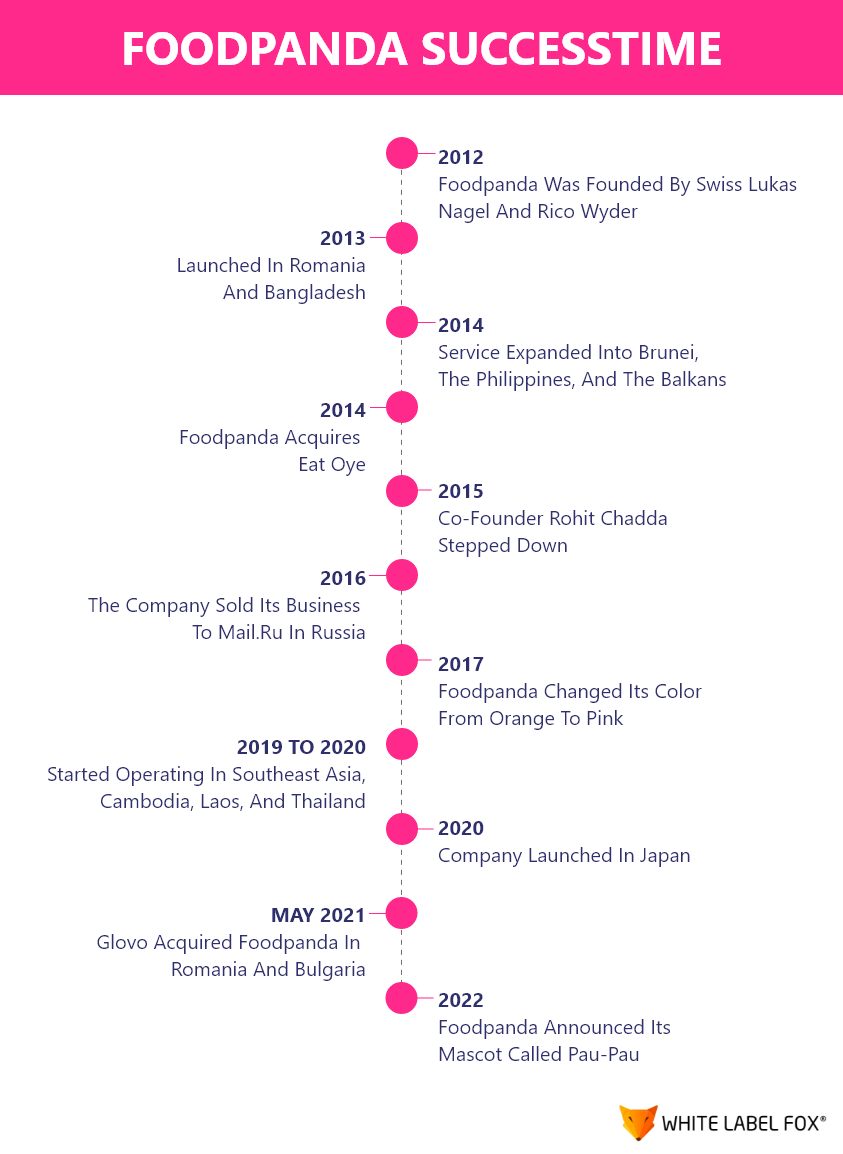
Foodpanda gobbled up $20 million in initial funding from Phenomen Ventures, Rocket Internet, and Investment AB Kinnevik in April 2013. Later, iMENA Holdings invested around $8 million in September 2013. There was another funding round of $20 million in February 2014 from a group of investors and Phenomen Ventures.
In August 2014, Foodpanda announced that it collected $60 million in financing from a group of investors. The food delivery giant raised another $110 million from Rocket Internet and other investors in March 2015. Two months later, Goldman Sachs, along with other investors, invested about $100 million.
Delivery Hero acquired Foodpanda in December 2016. You might have a clear idea about Foodpanda funding, investment, acquisition, and success time. Now let’s explore how Foodpanda works, and it’s business and revenue model right here.
Foodpanda Business Model: How Does Delivery Giant Satisfy Growing Demand?
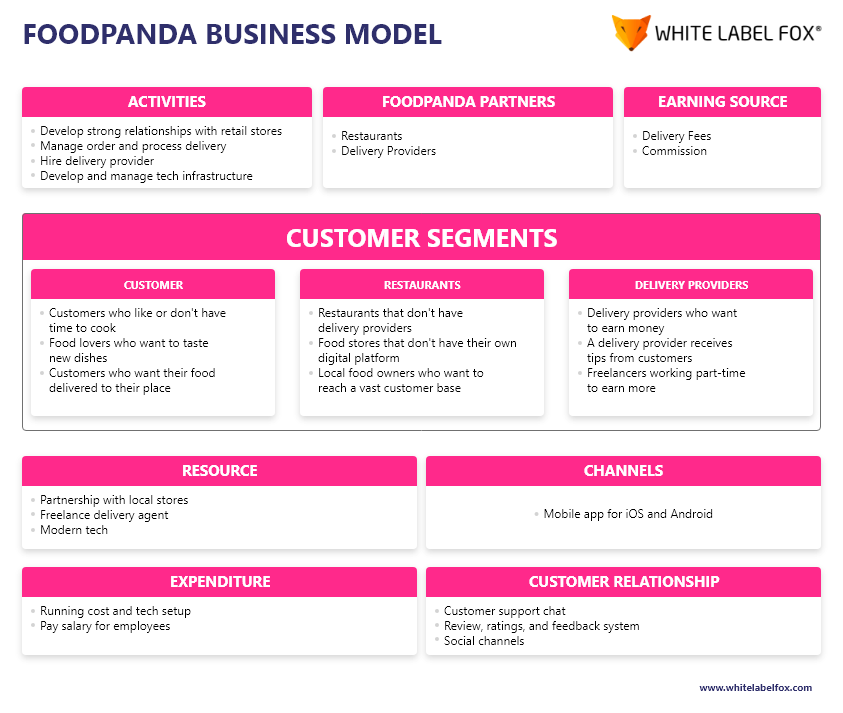
- Helps to meet the growing demand for hyperlocal online meal delivery services
- User Engagement
- Improved business control
- Supporting local restaurants
Foodpanda maintains a website and app that food lovers can use to order food from their favorite restaurants and eateries. In 2018, Foodpanda started providing special deals, offers, and discounts to increase platform traffic. The company has clocked around 30,000 to 35,000 orders per day before the approach. This number is expected to reach 5,000 daily orders in the future.
The delivery company continues in-house brands known as “cloud kitchens.” This concept was adopted by the delivery giant when it acquired Holachef. However, the company has three private-label brands in 2019 under its cloud kitchen business, including the FLRT and Great Khichdi experiment.
Customer Segments Multi-sided Foodpanda business model has two interdependent customer segments possessing its essential; this segment includes:
- Restaurant;
- Delivery agents.
Value Proposition The platform provides value propositions including cost reduction, brand status, accessibilities, convenience, and customization. Foodpanda develops accessibilities by permitting meal stores to promote their business to customers who want to visit a physical location and search for tribulation by searching the website online.
It allows customers to place orders from an online food ordering app or website, providing great convenience. They can get round-the-clock service from the delivery providers without any hassle. Customers can choose to pick up or get meals delivered right to their doorsteps.
The platform allows customers to filter restaurants as per their type. It also provides lots of engaging deals to customers, such as meal discounts, free deliveries, and more. Amazing offers boost customer engagement and encourage them to try something new and save their cost.
Cost Structure Foodpanda has built a strong brand with its effective business model. The delivery giant serves more than 500 cities in around 24 countries. An online ordering and meal delivery platform won the European Tech Startup Award in 2014 for “Best E-commerce Startup.”
The amazing cost-driven structure aims to minimize expense, boost significant automation, and surge store sales. However, the biggest cost drivers for the food delivery platform are advertising costs, employees’ salaries, etc. Few other drivers are like administration, customer support, etc.
How Does Foodpanda Work?
Effective Foodpanda business model provides great convenience to all the users. Customers can follow the easy registration and login process to use the platform. They can browse the nearby restaurant and their menu to place an order from them. Once they finalize the order, they can move to the check-out process and pay using multiple payment options like credit/debit cards or other payment options.
Once the customer places the order, the restaurant gets notified about the same. Then, the Foodpanda partner restaurant confirms the order and prepares the meal. As soon as the order is prepared, the restaurant requests a delivery provider to deliver the meal to the customer’s place.
The delivery agent then collects the order and delivers it to the customer’s place. The customer is allowed to track the process right from the moment the restaurant accepts their request through the delivery website and app. They can review and rate the restaurant and delivery provider as per their experience.
Many food ordering and delivery business entrepreneurs are getting inspired by a Foodpanda business model and the way it works to satisfy customers’ growing requirements and investing in an app similar to Foodpanda. If you are also looking for a meal ordering and delivery app development service, White Label Fox can help you with it. Contact our experts to get a free quote right away.
Foodpanda Revenue Model: How it Makes Money?
Most revenue of Foodpanda comes from restaurant commissions with which the delivery giant has partnered. Besides, it also generates revenue from other sources helping the company to generate great profits. The food ordering and delivery market generated around US$7.4 billion in 2021; this profit increased by 40% year-on-year.
Foodpanda segment revenue increased by 60% due to the COVID-19 pandemic; the revenue increased by US$616.2 million in the same quarter a year ago. Foodpanda has seen a great increase in revenue in recent years. The company generates revenue through various means like commission, advertisement, etc.
Restaurant Registration Fees Restaurants have to pay registration fees to register themselves with the Foodpanda website and app. Customers looking to satisfy their cravings can find eateries on the Foodpanda platform. The registration charges are between $100 to $150. It is a one-time payment for restaurants helping them to generate great profits.
Commission Restaurants have to pay a commission to Foodpanda for each order they get through the platform. They have to pay between 15 to 25% to Foodpanda with all taxes. The commission is determined based on the restaurant’s location and also on the volume and kind of orders the restaurant receives on the platform.
Delivery Fees Every order customers place through the Foodpanda platform is subject to delivery fees. This delivery charge depends on the distance that needs to travel between customers and the restaurant’s location.
Advertisement Many business entrepreneurs use Foodpanda as an advertising platform as it helps them boost their visibility. Businesses have to pay a steady fee to advertise their brand on this food ordering and delivery platform.
Affiliate Earnings The delivery giant makes money by making recommendations on different credit cards. It stimulates transactions; banks provide special deals and discounts on their cards. You can also use affiliate marketing to earn money like Foodpanda.
A food delivery app like Foodpanda has competed with many delivery giants and made its name in today’s competitive market. If you want to grab similar success, then you need to choose the right tech partner. Capitalizing on the dynamic method can help you provide your customers with what they are looking for.
Ending Note
Foodpanda has faced lots of ups and downs and has survived due to its effective business model. If you want to achieve similar success, then following the Foodpanda business model is the best option. We hope this blog might help you to know how Foodpanda works and makes money.
If you want to capture a vast base, then developing a delivery anything app is a smart choice to make. White Label Fox can help you give an online touch to your delivery business, get in touch to know how we help give a digital touch to your business and contact us at: [email protected] .

Leave a comment Cancel reply
Scaling up ‘rock-star fast’: A conversation with foodpanda’s Jakob Angele
In this episode of The Venture , we share a conversation with Jakob Angele, CEO of foodpanda APAC, the Asia–Pacific business of foodpanda, part of Delivery Hero’s global network of food-delivery services. Angele sat down with McKinsey’s Andrew Roth to reflect on building a business based on delivering a restaurant meal to someone’s home, which at the time of foodpanda’s founding was something new to consumers and restaurants alike. Angele describes foodpanda’s emphasis on speed, scale, and brand to build market share, even as competitors entered the market. At the close of the interview, McKinsey’s Dilip Mistry offers his insights.
An edited transcript of the podcast follows. For more conversations on venture building, subscribe to the series on Apple Podcasts or Spotify .
Podcast transcript
Andrew Roth: From Leap by McKinsey, our business-building practice, I’m Andrew Roth, and welcome to The Venture , a series featuring conversations with legendary venture builders in Asia on how to design, launch, and scale new businesses. In each episode, we cut through the noise to bring practical advice on how leaders can build successful businesses from scratch.
In this episode, I’m excited to share a conversation with Jakob Angele, CEO of foodpanda APAC, a leading food- and grocery-delivery platform in Asia. You’ll hear Jakob tell us about how foodpanda, under Delivery Hero, grew into a company with a $30 billion market capitalization, the new challenges it faces with COVID-19, and the culture of rock star–fast execution that helped them adapt to constant change in the early days. We also discuss how opening new markets in Asia can be like starting from zero for many start-ups, and how foodpanda approaches a launch campaign in strategic cities.
Jakob, thanks for joining us. Your company, foodpanda, and its parent, Delivery Hero, are such large organizations now, but there were some initial growing pains and problems to solve when you first joined. Tell us how you got involved and what were some of those initial problems.
Jakob Angele: I joined shortly after foodpanda was founded, roughly nine years ago. It has been quite an incredible journey. We started as a very small company, and food delivery back then was not really a hot topic. There was not much general interest by the media, there was not much money flowing into this industry, and we really had to do a lot of groundwork—not only educating potential investors but also educating business partners on why somebody would like to order food online. We encountered a lot of confusion around that, actually.
So in those early days, we did a lot of groundwork, especially here in Singapore, which was our first market. We, including myself, went around knocking on doors of different restaurants and signing them up. Even today, it’s really a one-by-one process. We signed up some restaurants that were interested in technology, but what we were missing were the really big brands like McDonald’s, Burger King, Pizza Hut, and so on. It was really challenging back then because those bigger companies didn’t really see online food ordering being a thing; they also didn’t really see the need for us.
Andrew Roth: Knocking on doors—I would imagine you’re not doing that today, but that must have been very formative to have gone through that experience when you started.
Jakob Angele: We do this much less today, but there are still aspects in our industry around signing restaurants one by one. In the meantime, we found scalable solutions for those nonscalable processes. But in the early days, restaurants weren’t as supportive of technology at all. It was a very manual process.
Andrew Roth: When you started to sign merchants up and they started to onboard and got through month one, month two, month three, were there moments where you thought, “OK, the data and stories we’re hearing from merchants are extremely positive”? When did you feel you had that product–customer fit?
Jakob Angele: For the first couple of years, I think merchants mainly signed up because they were interested in technology—maybe they were a young restaurant owner, a bit innovative, and so on. And to be honest, in the first couple of years, foodpanda wasn’t really a very sizable business line for them. They did probably 150 transactions a day in their outlet, and then maybe another three to five with foodpanda. It didn’t move the needle for them.
For us, I think there were many “making” moments, but one of them was definitely when we first started to break in and deal with the bigger brands. Here in Singapore, I still recall the first of those that took a leap of faith with us and said, “OK, we’ll give you guys a chance,” was Burger King. We started with one outlet as a test. With them, we also saw that, almost from day one, we picked up very decent orders and decent business volume, and then they expanded very quickly to market.
It took incredible effort to sign this one brand—like 20 or 30 meetings over one and a half years’ time. But then once we had this one flagship brand on the platform, all the other bigger brands were looking at foodpanda all of a sudden and thinking, “Are we missing out?” Then progress came quickly on the restaurant acquisition side.
Andrew Roth: So for Burger King, it took 20-plus meetings and more than a year to get them on. What happened when you did onboard them and they started using the platform?
Jakob Angele: Their expectations were quite moderate at first, but then after a couple of weeks, they were telling us, “This is really interesting. We are now live in one outlet. Can we maybe onboard another ten in two weeks’ time?” At that point, we understood that the revenues we provide to them are actually relevant for them. From there, the word spread, and then things started to move much, much quicker.
Andrew Roth: There’s also product–customer fit. Before you decide how to scale it, first of all, does your service or product solve the problem? With Burger King, you won them over once you were hitting these moderate targets that they had for you.
Jakob Angele: What’s interesting is, if you would have looked at foodpanda or the whole industry in 2014, you would have analyzed for product–market fit, and the analysis probably would have told you that it’s not a fitting product and the market doesn’t make sense. Years later, it would have still been a bit iffy.
I think the first problem was, while you may have the right product, you do need the right content. In a marketplace that includes top brands, beloved restaurants around the corner, it turns out for food delivery that the depth of restaurants you need is not only ten, it’s not only 20, but it’s hundreds and thousands. You need a lot. So that was the first challenge.
The other challenge, which kept us away a long time from this industry really taking off, was service experience. When we started out, delivery times were around 60 to 90 minutes, and the restaurants mainly did the delivery themselves, which sometimes worked well, but sometimes didn’t. It was very inconsistent. And back then, if you had looked at product–market fit, you would have said, “People just don’t want delivery in 90 minutes, and that’s a niche service. Maybe you do this once a quarter if you have a birthday party.”
To be honest, over a longer period of time, we were able, from a technology standpoint, to create a holistic product–market fit, which we have today. That also propelled the business growth over the last couple of years.
Andrew Roth: You’re saying that it can take time to get to predictable revenue, and you have to focus on the experience, the journey, and getting your content right—or, for foodpanda, the number and quality of restaurants onto the platform.
Jakob Angele: Exactly. It’s always important to reevaluate your business, especially your new ventures, if you’re a big MNC [multinational corporation] and launching different streams. It’s always important to keep a close eye on it and reevaluate if this business makes sense—and then to cut your losses fast if you have to.
At the same time, I think often you also need a vision behind it. And even if the numbers don’t make sense today, if somebody has a deeper belief in it and doesn’t look only at the numbers today but has a bit more imagination on where those numbers could lead to, that’s also very important. A lot of good ideas sometimes get killed too early.
Andrew Roth: This is a key topic, because incumbents, large MNCs, sometimes don’t even look at unit economics; they’re just looking at P&L. You’re not going to be cash-flow positive in month three or month four. You’re in this beginning stage, and you’re looking for product–customer fit; you might be looking at things like month-over-month user growth or month-over-month restaurant onboarding. As long as that part’s growing and you’re onboarding new merchants, onboarding new customers, then you can get into “OK, is the business profitable? Do we have predictable unit economics?”
Jakob Angele: I would agree with that. That’s important when looking at very early start-ups or business lines and the P&L still looks terrible. How do you evaluate if this is a good business or not?
One thing here that’s really important is that you don’t look so much into absolute numbers, but you look more into progress. The KPIs [key performance indicators] don’t look as good as they need to be, but are they moving slowly but surely in the right direction?
One metric we started to look at very early on was, for example, customer reorder rate. If a customer orders this month, how much is the chance that he’ll order again next month? In the very early days, this number was extremely low. I don’t want to disclose how low it was in 2014, but over many years, we gradually moved it up to higher than you would see on an e-commerce standard basis. We were able to move this up months on months, year on year, very consistently.
Want to subscribe to The Venture ?
Andrew Roth: That’s a great example of a number and tracking progress on that number. What typically happens in a start-up or an incumbent when launching something new is they measure things like registrations or subscribers, but not something a few layers deep for measuring if the customer is happy with the service, like reorder rate.
Outside of numbers, let’s talk a little bit about culture. Share with us how you’ve built up the culture and a few stories on how you been able to do that from your regional headquarters in Singapore.
Jakob Angele: The foodpanda business model is quite interesting in that regard. On the one hand, it’s a 100 percent technology play. You have all those technology aspects, like conversion on the website, online marketing, machine learning models, but, at the same time, it’s also a very, very heavy brick-and-mortar business with hundreds of thousands of restaurants, hundreds of thousands of riders. Between those different parties, a lot of things can go right and can go wrong.
Very early on, it was clear to us that, despite all the technological efforts, it’s a very heavy operational execution business model, so this rock-star speed of execution was very important. This is really important for a lot of start-ups, to execute fast. Companies often say they want to execute fast, but they are not 100 percent willing to buy into that, because every strategy you choose, every direction you go, always has a trade-off. So rock-star execution, of course, comes with the trade-off of excellence, perfectionism, fully thought-through solutions, and so on.
Of course, being a bigger company today, we changed a lot in those aspects of excellence. Some have become much more important for us, but, particularly in the early days, it was all about speed.
Andrew Roth: How did you enable that? Everyone talks about speed being important, but what were some of the ways you enabled speed?
Jakob Angele: If you have an early-stage start-up, fundamentally it’s a small company. People under- or overestimate how you create a culture and a mindset in an early-stage start-up. In a big MNC, what you do, of course, is you have a very structured process, you build a vision and values, and then you put those values in every meeting room; you include them in your performance review framework. All of those things are super important for bigger companies. But if you’re an early-stage start-up, it’s about getting senior leaders with the right mindset into the organization, getting them hooked on the right idea and the right approach. Then, because the company is so small, just by them living those values as an example for everybody else in the company really enables the right cultural mindset. In a bigger company’s incubator start-up, for example, they often underestimate the importance of the cultural mindset of the first couple of people they hire.
The other thing that helps to put start-ups on overdrive is to hire correctly. Many companies want to play it extremely safe when they hire people—especially if it’s a start-up and there’s a lot of money behind it already. So for, say, the head of sales, they hire somebody who was the head of sales for 25 years at a successful company. And the start-up might have a sales team of only ten people, but they’ll hire somebody who had a sales team of 80 people in the past. It looks great on paper, because that head of sales was excellent where they were before, but their past experience doesn’t help you to move your start-up company to rock-star speed.
What can work much, much better is to hire somebody who’s tremendously more junior but in whom you see a lot of potential. If you hire them as, in this example, the head of sales, the role will be a complete stretch for them. But if they have the right mindset, they will take it up as a challenge and somehow will make it work. Maybe a lot of things will break along the way, but that young head of sales will be very stretched and therefore more able to execute toward speed.
Andrew Roth: They’re hungrier perhaps to prove themselves.
Jakob Angele: Exactly. If you want to set up the perfect system and the perfect processes, then this inexperienced person would be a terrible choice. But if you’re optimizing execution speed, it’s important to take the chance on the less experienced person. If you’re talking about bigger companies incubating start-ups, that’s where those incubations often go wrong—where they make very safe choices on the people side and also move a lot of seasoned people from the headquarters organization into that incubator, where they have a lot of experience but not a lot of hunger and execution drive.
Andrew Roth: It’s the difference between hiring those first few key hires based on their CV versus the potential, as you said, you might see in someone.
Jakob Angele: And it becomes very different over time. What I’m describing was very much true for foodpanda in the first couple of years, but nowadays, with foodpanda being a very sizable organization, with thousands of employees across 12 countries, all those aspects I just described shifted. We are shifting much more toward structure, stability, planning, et cetera. It’s really about understanding where a company is at a given point in time.
Andrew Roth: Are there any principles you’re following to maintain that speed despite being a larger organization now?
Jakob Angele: Execution speed is always tied very closely to decision speed. If you have fast decision-making speed, it translates into faster execution. At foodpanda, at one point we reached a relevant size, and we were operating in eight markets, but those eight markets were extremely different—Bangladesh, Singapore, Thailand—they couldn’t be more different. We were asking ourselves, “How can we be successful in Bangladesh and Singapore with just one headquarters?”
We really pushed the decision making and the strategy downward in the organization, from the regional headquarters down into the country organizations. We saw that this was working very well, and so we did this across all aspects of the company, where we always try to have the decision making as closely connected to the execution part as possible. With that, we are able to make decisions much faster, which then also leads to much faster execution.
Andrew Roth: The scope of those decisions—are they decisions around budgeting, customer journeys, standard operating procedures? If I’m a salesperson in Thailand, do I have the freedom to do lots of things?
Jakob Angele: It depends, of course, on the decision. If you have a decision that, if it goes wrong, will cost you $50 million, obviously that cannot be made by a single person on a very junior level. But every decision has an average place where it sits in the hierarchy of the organization. In organizations that are slow moving, decision making is probably a couple of layers higher, and in faster-moving organizations, decision making is a couple of layers lower. For every kind of decision there is, we always try to have it at the lower end.
Of course, this comes with trade-offs. If you have decision making on the higher end, you have more thorough decision making. You make significantly fewer mistakes, probably, but you also make far fewer decisions, and the decisions take much, much, much longer. Also, if you make the decisions at a higher level, maybe they tie slightly better with the company’s strategy. But if you make them on a lower level, they tie better to the exact needs you have in that specific market or in that specific function.
For us and for myself, it worked really well to move decisions as low as possible in the organization, to really gain the speed. On paper, it probably looks like you would have higher-quality decisions if you move them upward, because the CEO is the best person to be making decisions. But more often than not, the decision-making quality is at least equally good if you make decisions on lower levels—and much faster.
Andrew Roth: I heard another CEO describe it as “Fast makes good before good makes fast.”
Jakob Angele: Exactly. And that’s a good thing, right? I’d rather have a very fast decision that gets executed at lightning speed and then two weeks later find out it was complete nonsense and doesn’t work at all, rather than simmering three months on the same decision and then deciding not to do anything.
Andrew Roth: I would imagine things have changed a bit because of COVID-19. Take us through how you were able to manage this question of central versus local empowerment or execution during the pandemic.
Jakob Angele: COVID-19 has been very challenging for all companies, and foodpanda is no exception. We definitely didn’t come out on the worst end of it, but it’s been a crazy, busy time, with huge amounts of challenges. When COVID hit, we had very diverse situations in all the different countries, with very different reactions from the regulators.
What we see a lot of, especially in the tech industry, is global headquarters churning out global guidelines: “Across all our offices around the world, on Monday we’ll work from home, because COVID is serious and everybody needs to stay safe.” This sounds very good on paper, but we believed it didn’t fit the needs of many countries we are in. So here again, localized decision making comes into play. Already the countries were empowered to make decisions by themselves. Without myself and the regional headquarters guiding or interfering much, all the different countries—and also different cities within the countries—made very different decisions on how to react to COVID, from a team perspective, from a business perspective, and so on. With that, we found a good reaction for all those different markets.
It was really a second step when my original team and I asked ourselves, “How can we support the countries in a structured way from the regional team side?” A lot of points came back to technology, which we run in a centralized fashion. We decided, for example, to churn out a no-contact delivery feature, which we churned out within one and a half weeks. A bit more strategically, we were somewhat in the process to launch our grocery business, so we decided regionally to put this on overdrive and launch groceries and our pandamart business across all those countries even faster than we were originally planning.
Andrew Roth: That’s incredible speed—for contactless delivery to go from ideation to deployment on the platform in just a week and a half.
Jakob Angele: From first discussions to going live in the first market, I think it was less than two weeks. The teams did an amazing job of churning this out as fast as possible. Our success with it really came down to (a) just making the decision very fast, and (b) we also brutally “de-spec’d” the feature. We created a very simple, functional feature, which served the needs of the market at that point in time and therefore contributed very fast.
Andrew Roth: Take us into one of those meetings. I’m sure it can get emotional on what you decide to de-scope. How did you arrive at decisions in these meetings? Was it a top-down approach or through voting?
Jakob Angele: In general, we try to avoid the top-down approach. The teams were excited because they knew COVID is something serious, the countries are struggling with it, and they were just excited that we could find a very quick thing where the product and tech team could support the country teams. And so it was really all hands on deck. I think everybody knew from the get-go that this will be a quick fix and after the fact will need some cleanup. As long as you’re committed to cleaning it up later, most people are quickly aligned.
Andrew Roth: You recently launched in Japan. What we’re finding across lots of organizations right now is that there is balancing required between awareness and acquisition, branding versus performance marketing. When you decide to launch in new markets, how do you typically balance these two things?
Jakob Angele: In Japan, we knew that we wanted to make progress very quickly, because other companies were also preparing to launch, so it was really a race to the finish line. At the same time, we also knew it would be a longer race, because there was already a sizable player in Japan, and it would take some time to catch up. We wanted to move very fast, but we had a long way to go, so it was quite a complicated situation.
Talking about this kind of trade-off between awareness of branding versus direct-impact marketing, what we did is, whatever our models and optimizing considerations spit out in terms of what split to take in terms of marketing, we just topped it up quite a bit on the branding side. No analytical model gives you the full truth, especially on aspects like branding and awareness, and we just wanted to launch in the market with a splash and really build our presence there. It’s hard to quantify, but there are very long-term benefits to building brand awareness as early as possible. If you don’t have many restaurants yet, you don’t have much geographic coverage, so whatever influencer marketing you do, it doesn’t really convert into orders, because you simply don’t have the coverage yet. So we signed up a tier-one influencer right in the beginning for the launch. We also went very early with out-of-home TV marketing. We were quite happy with the results.
For example, we launched outside of Tokyo first, in ten cities across the various Japanese islands. After five months or so, we launched in Tokyo. But even before the launch in Tokyo, we had higher brand awareness than some of the food-delivery players who were already present in Tokyo, because of the high investment in awareness early on. Then the great thing was, once we launched in Tokyo, it was a bit like, “Finally, you guys are here. I keep hearing about you.” So the money was not completely wasted. It helped us have a good launch right from the get-go.
Andrew Roth: Tell me a little bit more about the influencer. Was this person a social-media influencer or a celebrity?
Jakob Angele: It was a widely known celebrity, Naomi Watanabe. She’s quite prominent now also in the rest of Asia. She had a very good brand fit with us. She’s very funny, first and foremost, and also quite quirky. On top of that, when we analyzed the Japanese food-delivery market, one thing that stuck out was that the marketing was very traditional, focusing on standard attributes like speed, assortment, price, which all players do. So we tried to introduce a more emotional component, rather than just strict attributes, and she was really a perfect fit, because it’s easy to connect to her. That was one of our criteria.
Would you like to learn more about Leap , our business-building practice?
Andrew Roth: What about attribution? Have you found other ways to drive attribution?
Jakob Angele: We are spending significant money in awareness marketing. And, fundamentally, that type of marketing is hard to track. We undertake all efforts we can to make the nontrackable trackable. Probably the biggest tool we use is recurring top-of-mind surveys with rather sizable panels, where we measure our top-of-mind performance, our performance across different attributes, like emotional attachment versus how they perceive speed, the price, and so on.
For TV, things are quite traceable and trackable. So we do see quite good correlations there for short and long term. And we also play around with different marketing strategies across different cities. We might run a TV campaign in five cities, and then we exclude one city and, with a bit more data science behind it, get the data out of it long term and short term.
Andrew Roth: On your last point, we’re seeing a trend toward trying to measure awareness-type campaigns, whether it’s offline or online, by turning it on in a few strategic locations, turning it off in one location, and then measuring the incrementality between those two locations to measure effectiveness.
Jakob Angele: It never really solves for the long-term impact. If I’m doing heavy TV today, what is the impact of this in one year? That is the crux of the problem. You can fix it to some extent, but then only one year later, when you have the data, which then doesn’t really help you much because everything changed in the meantime.
A great tool on a macro level is to track top-of-mind performance. If you see you’re trending slowly but surely in the right direction, you know you’re doing something right.
Andrew Roth: Especially for incumbents that are trying to launch and break into a competitive space, like Japan was for you, would a split between awareness and acquisition be 50–50 or 60–40?
Jakob Angele: Those are the food-delivery trade secrets. But to be fair, I think it’s business-model specific. If you run a property marketplace, this might be very different than for a food-delivery business.
Whenever we went a bit heavier on brand and awareness marketing, we hardly had a situation where we regretted that. Vice versa, if you optimize too much toward some short-term impact and ditch too much of your marketing just in conversion and chasing the next order or the next transaction, then there is a risk of missing out on something.
Andrew Roth: If we just focus on acquisition tactics and we don’t find those emotional hooks with the customer and the brand, then the dollars you spend on marketing are just competing with other clicks and your competitors. Whereas the awareness campaign, the content strategy, and the emotion around it are what can build that moat around your brand.
Jakob Angele: Especially for early-stage start-ups, if you don’t build an emotional brand from the get-go and you focus from day one on measurable, tangible attributes, it’s quite difficult to move away from that at a later stage.
Andrew Roth: Jakob, thanks for sharing about your early days creating rock star–fast execution.
Jakob Angele: Thanks for having me.
Andrew Roth: Now comes a segment where we invite experts from McKinsey to provide more context and to draw practical insights. Today I’m joined by Dilip Mistry, a partner and venture builder with McKinsey, based in Asia. Dilip is also a leader at McKinsey Digital Labs and co-leads our business-building practice, Leap by McKinsey. Dilip, thanks for joining us.
Dilip Mistry: Good to be here.
Andrew Roth: Jakob opens up in this interview on the topic of speed, and we talk about rock star–fast execution. What are some of your thoughts from your experience on how incumbents specifically can create this type of speed?
Dilip Mistry: Speed is a really important topic, and I think you can have the right speed at the right time. Jakob talked about the fact that it took him a little while to get product–customer fit, and it even took a while to do that big deal with Burger King—if I remember, it was something like 12 to 24 months. In the early days, it might take a while just to figure this out. But once you figure out the formula to win, once you figure out the business model, you do need to move fast.
And to actually move fast, I feel a lot of it comes down to leadership style. The leadership has to role-model pushing decision making down, which is what Jakob talked about. The leadership has to role-model that some of these risks can actually be borne by people closer to the field, so to speak. And then a healthy dose of a kind of paranoia as well—that if we’re not moving fast enough, then the competition is going to come and take over. I think the leadership needs to role-model the culture that you want so that fast decisions can actually take place.
Andrew Roth: There’s some trade-off there as well. When you push down decision making to the frontline team, they might sometimes make the wrong decision or not the most optimal decision, but you get speed instead of perfect.
Dilip Mistry: That’s right. There is a trade-off, but you also get multiple experiments happening. As long as you’ve created a culture of people thinking, “Let’s learn from these experiments, and let’s make sure we’ve got a feedback loop so that everyone can learn from them,” then I think you can move much, much faster.
And I think some of those ideas do come from people who are close to the ground. Certainly in the years that I’ve been helping corporates build new businesses, some of the best ideas come from people who are closest to the customer. They’ll come out with ways to reduce processes. You’ve also got people on the front lines playing with different tools as well. We all use tools such as Slack and Jira, and these didn’t come from corporate headquarters. They come from people at the coalface, so to speak; they come up with these ideas. So create a culture where people closest to the customer, closest to the engineering, can come up with ideas and then run with them.
Andrew Roth: That’s a good segue to Jakob talking about how foodpanda was able to adapt to COVID-19 by quickly creating contactless delivery, and pulling it off in just a few weeks, which would show that they have a product culture as well, where they can quickly adapt, ship new code, and get things into production.
For incumbents that are working on legacy systems and with a different type of speed, we find that it’s hard to create this product culture. What can you share with incumbents that hear all these great things about how start-ups move fast? What are some specific ways they can think about it?
Dilip Mistry: People have this notion that start-ups are working 24/7 and just cranking out the code. The reality is they’re making smart decisions, such as buying before they build. A lot of times, there’s a lot of software available in various kinds of code repositories, and it’s sometimes quicker just to buy a piece of software. Certainly, if it’s a piece of software that doesn’t differentiate your experience, just buy that, use it, and get it out to market. You may want to build some of it on your own in future releases, but “buy before you build” is a key philosophy that I would encourage corporate business builders to think about.
Also, when you want to get stuff out to market, you might actually create a bit of technical debt—and you need to accept that. If you want to get something out and you want to test it, you might need to hold off on optimization and cleaning up some aspects of your software until later. That’s OK, as long as you accept this technical debt.
Andrew Roth: What is technical debt?
Dilip Mistry: Technical debt happens when you’re busy building software and you choose to take shortcuts that let you build the software quickly. What that means is that there are things that need to be “straightened out” in a future version. For example, you might be writing an algorithm to do a particular calculation, and that algorithm might have been executed in a long-winded way, but it allows you to release to market very quickly. The algorithm can be optimized and written a lot better, a lot smarter, but you might hold off on that for a future release, because you just want to get the formula around, as opposed to having the perfect algorithm. You just have to accept that technical debt.
Andrew Roth: What else should incumbents consider?
Dilip Mistry: The final thing I would think about is that you don’t have to do everything yourself. A lot of interesting software companies actually are able to create platforms and encourage communities to build on top of what you’ve done. If you can do that early on in your venture-building experience, where you make it easy and you publish an API, you publish documentation, and you can encourage the community to build on your behalf, then you can extend what is effectively your development team. There are many creative ways in which you can get stuff out faster and not have to do everything yourself.
Andrew Roth: I like what you’re saying about the developer community. If you build something that the ecosystem can leverage, whether it’s data through APIs or access to system functionality, that’s another way to grow a product, versus just the consumer side of it. You make it open enough where the developer community can interact, and that can help expand your product team as well.
Dilip Mistry: If you look at all the famous products, all of them get to a stage where they start talking about the word “platform.” But I think even before you become a platform, if you do a good job in documentation, getting your API correct, making sure the hooks are well defined, people will build on top of what you’re doing, because we all want to get to a better place. It’s an interesting approach, which corporate venture builders can take as well.
Andrew Roth: Then what about this third topic we spoke about with Jakob: branding versus performance marketing? There’s a lot of focus on performance marketing—understanding your click-through rates, your conversion rates from all the different platforms out there: Facebook, Google, and TikTok. And then there seems to be almost an overindex toward performance marketing. Now we’re seeing a shift back to branding, where advertising on traditional media is starting to go up because it’s just less expensive now than it used to be. What do you think about branding versus performance marketing?
Dilip Mistry: I’m big on data, and I’m big on accountability, so I’m a big fan of performance marketing. At the same time, there is a need for brand marketing. Maybe the pendulum has swung a little bit too far in the direction of performance marketing, but the brand is something that an incumbent—a corporate—already has. And that’s a huge advantage compared to start-ups in that space, so they should definitely use that.
There are lots of theories around what marketing is, but the thing about an incumbent is that there is often trust in a large entity. If you can play on that trust aspect of a brand, that’s a huge differentiator compared to a start-up, which may or may not be around for long, so you should play to that. Why not get your absolute strength?
When I speak to my corporate clients, corporate venture building is a never-ending experiment—constantly iterating and constantly trying to make use of the resources you have. And if you have that mindset—constantly experimenting, constantly learning, constantly adapting—you will be successful in the long run.
Andrew Roth: Dilip, thanks for joining.
You’ve been listening to The Venture with me, Andrew Roth. If you like what you’ve heard, subscribe to our show on Apple Podcasts , Spotify , or wherever you listen.
Andrew Roth is an associate partner in McKinsey’s Singapore office, where Dilip Mistry is a partner. Jakob Angele is the CEO of foodpanda APAC.
Explore a career with us
Related articles.

How to launch a new business: Three approaches that work

Why business building is the new priority for growth

Differentiation through constant innovation: A conversation with Ninja Van’s Lai Chang Wen

The Leading Source of Insights On Business Model Strategy & Tech Business Models
How does Foodpanda make money?
Foodpanda is an online grocery and food delivery service owned by the European multinational company Delivery Hero.
Foodpanda was started in 2012 by Benjamin Bauer, Christian Mischler, Felix Plog, Kiren Tanna, Ralf Wenzel, Rico Wyder, Rohit Chadda, and Simon Schmincke.
Each of the founders was working for the German incubator Rocket Internet at the time, which was known to take proven business ideas and introduce them to underserved regions.
One such region was Southeast Asia, where it soon became apparent that the food delivery and grocery market was ripe for exploitation.
In April 2012, Foodpanda was launched in Malaysia, Singapore, Thailand, and India, among other countries. Within twelve months, the service had partnered with thousands of restaurants across 27 countries.
Around 2015, Foodpanda changed its restaurant aggregator business model in response to the emergence of smartphones in the Southeast Asian region.
Similar platforms such as DoorDash provided their couriers, allowing many restaurants to offer takeaway but not be required to deliver the food themselves.
By the end of 2016, Rocket Internet sold Foodpanda to Delivery Hero. As a result of the acquisition, Delivery Hero hoped to process over 20 million orders per month in 47 countries .
Further expansion saw the Foodpanda platform offered in Myanmar, Cambodia, Japan, and Laos in 2019 and 2020.
Today, Foodpanda partners with more than 115,000 restaurants around the world in over 400 cities .
Table of Contents
Foodpanda revenue generation
Foodpanda has a typical revenue generation strategy for a food delivery business . The company utilizes the marketplace business model , matching riders and restaurants with customer demand.
A more detailed look at revenue generation is provided below.
Commissions
Foodpanda makes most of its money through restaurant commissions.
When a consumer places a food order, the company charges anywhere from 25 to 30% of the total order amount to restaurants.
Delivery fees
Consumers ordering food also pay delivery fees, with the exact fee depending on the country-specific market.
Fees are also contingent on how close the customer is to the restaurant, with larger distances commanding higher delivery fees.
Foodpanda also charges delivery fees as part of its Pandago service. Other businesses can utilize its fleet of couriers to make same-day deliveries on food, groceries, documents, and other retail products.
Because Foodpanda cannot collect a restaurant commission from these orders, the delivery fee is likely to be much higher to compensate.
Subscriptions
Pandapro is the name given to a monthly subscription program for consumers, allowing them to receive exclusive deals and benefits. Such perks include free delivery and access to various discounts and vouchers.
The subscription fee charged depends on the consumer’s country of residence.
Grocery sales
Grocery sales are handled through a service called Pandamart, an on-demand platform selling over 3,500 daily essentials such as fresh produce, household items, beauty products, and medication.
Products are stored and distributed from Foodpanda-owned and operated warehouses. To make a profit , it can be assumed the company is marking up prices on certain items.
Key takeaways:
- Foodpanda is an online grocery and food delivery service owned by the European multinational company Delivery Hero. The founders of the platform worked for Rocket Internet, a start-up incubator known for replicating successful business models in underserved markets.
- Foodpanda adheres to a typical revenue generation strategy for a food delivery business . It charges restaurants a commission fee and consumers a delivery fee.
- Foodpanda also offers a consumer subscription service, giving them access to various discounts and perks. The company also operates an on-demand grocery platform for household staples and other essential items.
Key Highlights
- Founding and Expansion: Foodpanda was founded in 2012 by a group of entrepreneurs working for Rocket Internet. It started as an online food delivery service in Southeast Asia and quickly expanded to multiple countries including Malaysia, Singapore, Thailand, and India.
- Business Model Evolution: In response to the rise of smartphones and changing market dynamics, Foodpanda transitioned from a restaurant aggregator model to a platform that also provided delivery services. This allowed restaurants to offer takeaway without needing to manage their own delivery logistics.
- Acquisition by Delivery Hero: In 2016, Delivery Hero acquired Foodpanda from Rocket Internet. This acquisition aimed to enhance Delivery Hero’s global reach and processing capacity, with the goal of handling millions of orders monthly across numerous countries.
- Global Reach: After the acquisition, Foodpanda continued to expand its services into new markets, including countries like Myanmar, Cambodia, Japan, and Laos. As of now, it partners with over 115,000 restaurants in more than 400 cities around the world.
- Revenue Generation: Foodpanda’s revenue primarily comes from several sources, including restaurant commissions, delivery fees, subscriptions, and grocery sales.
- Restaurant Commissions: Foodpanda charges restaurants a commission fee for each order placed through its platform. This fee typically ranges from 25 to 30% of the total order amount.
- Delivery Fees: Customers ordering food are charged delivery fees, which vary depending on the specific market and distance between the restaurant and the customer. The company also offers its delivery fleet for same-day deliveries of various products.
- Subscription Service: Foodpanda offers a subscription program called Pandapro, allowing customers to access exclusive deals, free delivery, and discounts for a monthly fee. The subscription cost varies based on the customer’s country.
- Grocery Sales: Foodpanda operates Pandamart, an on-demand grocery platform that sells essential items such as fresh produce, household goods, beauty products, and medications. The products are stored and distributed from Foodpanda-owned warehouses.
- Market Presence: Foodpanda’s platform has a dual role of connecting customers with restaurants and providing a convenient channel for groceries and other essential items. Its global presence and versatile offerings make it a prominent player in the food delivery and online grocery sectors.

Related Business Models
DoorDash Business Model

Glovo Business Model

GrubHub Business Model
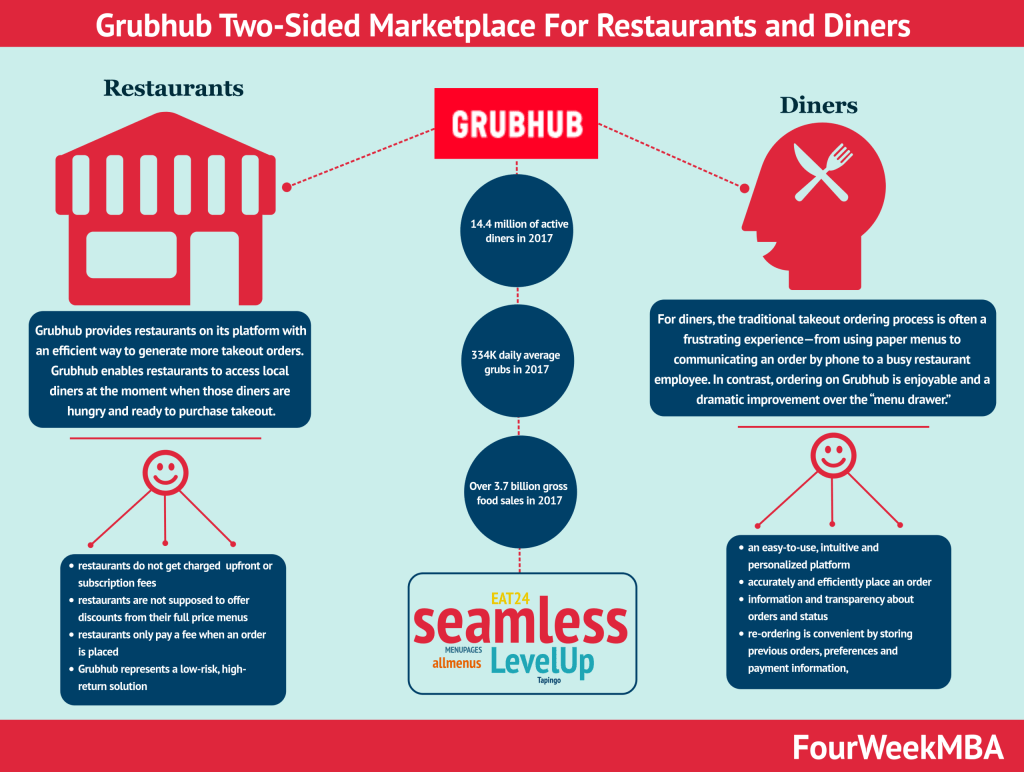
Instacart Business Model

Lyft Business Model

- Uber Business Model

Postmates Business Model

Uber Eats Business Model

Coupang Business Model

- Amazon Business Model

Getir

More Resources

About The Author
Gennaro Cuofano
Discover more from fourweekmba.
Subscribe now to keep reading and get access to the full archive.
Type your email…
Continue reading
- 70+ Business Models
- Airbnb Business Model
- Apple Business Model
- Google Business Model
- Facebook [Meta] Business Model
- Microsoft Business Model
- Netflix Business Model

Foodpanda PESTEL Analysis
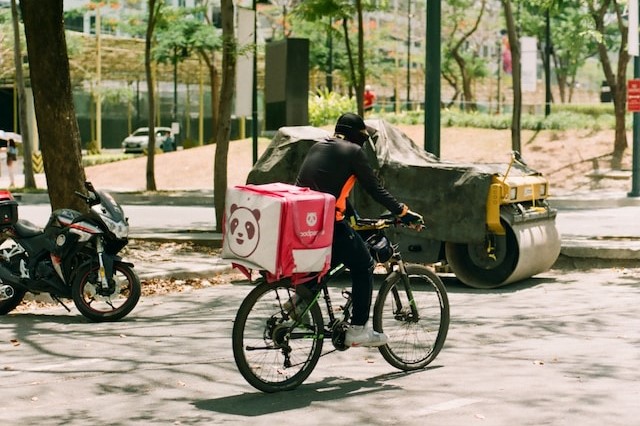
Before we dive deep into the PESTEL analysis, let’s get the business overview of Foodpanda. Foodpanda is an online food and grocery delivery service that connects people with the best in their cities. The company operates in multiple countries, primarily in Asia and Eastern Europe.
In 2016, Delivery Hero, a leading global online food ordering and delivery marketplace, acquired Foodpanda. Foodpanda operates in Bangladesh, Cambodia, Hong Kong, Laos, Malaysia, Myanmar, Pakistan, the Philippines, Singapore, Taiwan and Thailand.
Foodpanda allows users to select from local restaurants and place orders via its mobile applications and website. The service is often considered convenient, as it enables customers to order a wide range of food options with a few taps on their smartphone or clicks on their computer.
Business Model
The Foodpanda business model typically relies on three primary stakeholders:
- Customers: Individuals or organizations that use the Foodpanda app or website to order food or grocery items.
- Restaurants and Retailers: Foodpanda partners with restaurants and food outlets and, in some locations, grocery stores. These partners list their menu items or products on Foodpanda’s platform.
- Delivery Riders: Individuals responsible for picking up orders from restaurants or stores and delivering them to customers.
Revenue Streams
- Commission: Foodpanda usually charges a commission from the restaurant on each order placed through its platform.
- Delivery Fees: Customers often pay a delivery fee unless they meet a certain minimum order value or subscribe to a premium service.
- Advertisements and Promotions: Foodpanda may also generate revenue by providing advertising space on its app or website or offering restaurant promotional deals.
As per Delivery Hero’s 2022 annual report , the Foodpanda brand in APAC
has shown adjusted EBITDA improvements through efficiency in marketing spend and investing in healthy customer retention activities such as the rollout of the subscription model, thus focusing the marketing spend on higher value customers through audience targeting.
Here is the PESTEL analysis of Foodpanda
A PESTEL analysis is a strategic management framework used to examine the external macro-environmental factors that can impact an organization or industry. The acronym PESTEL stands for:
- Political factors: Relate to government policies, regulations, political stability, and other political forces that may impact the business environment.
- Economic factors: Deal with economic conditions and trends affecting an organization’s operations, profitability, and growth.
- Sociocultural factors: Relate to social and cultural aspects that may influence consumer preferences, lifestyles, demographics, and market trends.
- Technological factors: Deal with developing and applying new technologies, innovations, and trends that can impact an industry or organization.
- Environmental factors: Relate to ecological and environmental concerns that may affect an organization’s operations and decision-making.
- Legal factors: Refer to the laws and regulations that govern businesses and industries.
In this article, we will do a PESTEL Analysis of Foodpanda.
PESTEL Analysis Framework: Explained with Examples
- Government Regulations and Policies : Foodpanda operates in multiple countries, each with its own set of regulations regarding food safety, health standards, and business operations. Failure to comply with these regulations can result in severe penalties and even bar the company from operating in certain jurisdictions.
- Political Stability : Political instability can result in unpredictable business conditions, including regulation changes, currency value, and consumer behavior. For example, political unrest can lead to strikes or protests that may disrupt the supply chain or pose security risks to delivery drivers.
- Trade Policies : Policies related to tariffs and trade can affect Foodpanda, especially if it sources its technology or goods from abroad. These policies could affect the cost structure and, subsequently, the pricing strategies.
- Taxation : Different tax regulations, including sales tax, corporate tax, and other levies, could affect Foodpanda’s profitability. Moreover, cross-border taxation issues might arise if the company operates in multiple countries.
- Public-Private Partnerships : In some countries, governments may collaborate with private companies like Foodpanda to promote local cuisine or create job opportunities. Such partnerships could provide Foodpanda with both opportunities and obligations.
- Data Security Laws : Foodpanda operates primarily as an online platform, so political decisions around data security and privacy regulations can significantly impact its business model.
- Employment Laws : Different countries have diverse laws regarding employee benefits, minimum wages, and working conditions. Since Foodpanda uses delivery riders as part of its workforce, these laws can affect labor costs and operational efficiency.
- Lobbying and Political Influence : Foodpanda, like many corporations, may engage in lobbying efforts to advocate for favorable policies. This could include efforts to influence regulations around gig economy workers, a hot topic in many countries.
- Economic Growth : Economic prosperity generally leads to increased disposable income, which could result in higher demand for convenience services like food delivery. Conversely, economic downturns could reduce consumer spending, affecting Foodpanda’s revenue.
- Inflation Rates : Inflation affects the cost of goods and consumer purchasing power. High inflation may increase Foodpanda’s operating expenses, such as food costs, fuel, and labor, potentially forcing the company to raise prices and risk losing cost-sensitive customers.
- Interest Rates : Interest rates can impact Foodpanda’s financing costs. High interest rates could make borrowing costly if the company seeks external funding for expansion or operations. This would increase the company’s operational costs and could affect profitability.
- Unemployment Rates : High unemployment rates could have a dual impact. On the one hand, it might increase the pool of potential delivery riders. On the other hand, high unemployment could decrease consumer spending, affecting Foodpanda’s revenue.
- Currency Fluctuations : Foodpanda operates in multiple countries and is exposed to currency risk. Changes in exchange rates can impact the company’s financial performance, particularly if it has costs in one currency and revenues in another.
- Competition and Market Saturation : Economic factors like market saturation and competition can also influence Foodpanda’s profitability. In a booming economy, more competitors might enter the market, affecting Foodpanda’s market share and pricing strategy.
- Regulatory Costs : Economic conditions may influence the level of regulatory scrutiny and costs associated with compliance. In difficult economic times, governments might increase regulations to protect jobs or increase tax revenues, affecting Foodpanda’s operational costs.
- Fuel Prices : Fuel cost is a significant operational expense for a delivery service like Foodpanda. Economic conditions can significantly impact fuel prices, thereby affecting the cost structure and profitability of the company.
Sociocultural
- Eating Habits and Lifestyles : Changes in eating habits, such as a shift toward health-conscious eating or convenience foods, can significantly impact the demand for Foodpanda’s services. The rise of on-the-go lifestyles may increase the demand for quick and convenient food delivery services.
- Cultural Preferences : Foodpanda operates in multiple countries, each with unique cultural preferences for food and eating habits. Understanding and catering to these local tastes is crucial for market penetration and customer satisfaction.
- Social Norms and Taboos : Some societies may have specific norms or taboos regarding food, such as dietary restrictions based on religious or ethical beliefs. Foodpanda must be sensitive to these factors when partnering with restaurants and presenting menu options.
- Demographics : The age distribution within a particular market can also affect demand. Younger populations may be more tech-savvy and more likely to use an online food delivery service, whereas older populations may prefer traditional methods of ordering food.
- Work-Life Balance : Cultural attitudes towards work-life balance can impact the frequency with which people order food online. In cultures where long work hours are common, there may be a higher demand for convenient meal options, thus positively affecting Foodpanda.
- Consumer Attitudes Towards Technology : Consumers’ level of comfort and trust with digital technology and online transactions can influence how widely Foodpanda’s services are adopted in a given market.
- Time-Saving Preferences : As life gets busier, more people look for ways to save time, making convenience a major selling point. This societal shift towards valuing time-saving options could benefit a service like Foodpanda.
Technological
- Platform Reliability and Scalability : The reliability and performance of Foodpanda’s app and website are vital. Downtime or glitches can lead to lost revenue, frustrate users, and damage the company’s reputation. As the company expands, the technology must scale efficiently to handle increased traffic and orders.
- Cybersecurity : Given that Foodpanda stores sensitive customer data, including payment information, maintaining a high level of cybersecurity is essential. Any data breaches or cyber-attacks could severely tarnish the brand and result in financial and legal repercussions.
- Data Analytics : Effective data analytics can give Foodpanda a competitive edge. Data can help understand consumer behavior, optimize delivery routes, and even make real-time marketing decisions.
- Automation and AI : Artificial Intelligence and machine learning algorithms can optimize various operational aspects, from inventory management for partnered restaurants to route optimization for delivery drivers. Automation can also improve customer service through chatbots and automated support systems.
- Payment Technologies : The rise of digital wallets, cryptocurrencies, and other innovative payment methods could affect how transactions are conducted on Foodpanda. Adopting new payment technologies may attract a new customer base or improve the convenience of the service.
- Internet Penetration and Quality : Internet service availability and quality can impact Foodpanda’s potential user base. The company might face challenges in regions with poor internet connectivity in offering a seamless service.
- Mobile Technology : As a mobile-first platform, Foodpanda benefits from advances in smartphone technology and mobile operating systems. The widespread adoption of smartphones directly correlates with the potential market size for Foodpanda’s services.
- GPS and Location Services : Advancements in GPS technology can improve the accuracy and efficiency of Foodpanda’s delivery service, thereby enhancing customer satisfaction and reducing costs.
Environmental
- Carbon Footprint : The company relies on a fleet of vehicles for delivery, contributing to its carbon footprint. As awareness and concern about climate change grow, Foodpanda might face pressure to reduce emissions, either through the adoption of electric vehicles or more efficient routing algorithms.
- Packaging : Food delivery services often use a significant amount of packaging, contributing to waste and environmental degradation. Sustainable, biodegradable, or reusable packaging options could become necessary to meet consumer demands and comply with regulations.
- Food Waste : Food preparation and delivery efficiency can help reduce food waste, a significant environmental issue. Foodpanda may need to collaborate with restaurants to address this aspect, possibly leveraging technology to match supply with demand better.
- Local Sourcing : There’s a growing movement towards locally sourced food due to its lower environmental impact. Foodpanda could consider partnerships with restaurants prioritizing local sourcing to appeal to environmentally-conscious consumers.
- Water Usage : Water scarcity is a growing concern globally. While Foodpanda is not directly involved in food preparation, partnerships with restaurants that employ water-efficient practices could benefit both from a sustainability and public relations standpoint.
- Regulatory Compliance : Environmental regulations are becoming stricter across many jurisdictions. Whether it’s emissions standards, waste management, or other environmental protections, Foodpanda must be prepared to meet these challenges.
- Employment Laws : As Foodpanda employs delivery riders and staff in various roles, it must adhere to local labor laws, which can differ widely by country. These may include minimum wage laws, worker benefits, and conditions for employment contracts.
- Food Safety Regulations : Foodpanda is not directly involved in food preparation but facilitates food product delivery. Consequently, it might be subject to food safety laws to some extent, especially in how the food is transported and handled during delivery.
- Consumer Rights : Consumer protection laws covering data privacy, product safety, and complaints handling must be strictly followed. Failure to comply can result in hefty fines and damage to reputation.
- Intellectual Property : Legal aspects around the use of proprietary technology, trademarks, and copyrights must be managed carefully to avoid potential lawsuits and penalties.
- Data Protection and Privacy : Given that Foodpanda collects customer data, it must comply with data protection regulations like GDPR in Europe or similar laws in other jurisdictions. This includes how data is stored, processed, and shared.
- Licenses and Permits : Operating in multiple countries means Foodpanda must acquire and maintain a variety of licenses and permits, which may include business licenses, vehicle permits for delivery, and potentially even licenses for storing food in some instances.
- Contract Law : Foodpanda enters into contracts with restaurants, delivery personnel, and customers. Legal issues related to contract formation, enforcement, and disputes are critical considerations.
- Advertising and Marketing Laws : Promotional activities must adhere to advertising standards and laws that prevent misleading or false claims. These can be particularly complex when operating across multiple jurisdictions.
- Cybersecurity Laws : Given that Foodpanda is an online platform, it must also abide by laws governing cybersecurity and online transactions. Non-compliance can result in fines and damage to reputation.
- Gig Economy Regulations : The status of delivery drivers as independent contractors or employees is a contentious legal issue in many jurisdictions. Legislation in this area could significantly impact Foodpanda’s cost structure and operational model.
Check out the PESTEL Analysis of Global Businesses
Related posts.

Siemens PESTEL Analysis

Lush Cosmetics PESTEL Analysis

AstraZeneca PESTEL Analysis

Carrefour PESTEL Analysis

Jaguar Land Rover PESTEL Analysis
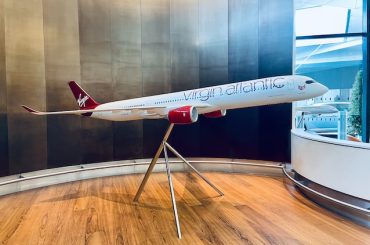
Virgin Atlantic PESTEL Analysis

HSBC PESTEL Analysis

Delta Air Lines PESTEL Analysis
Type above and press Enter to search. Press Esc to cancel.
- How to use ready-made taxi booking script to start your business
- Abservetech announces a 50% discount on all products
- Best UberEats Clone Script in 2024
- How to choose a Best Uber Clone Script?
- Best Swiggy Clone App in 2024
- Best Vacation Rental script in 2024
- Best Online Classified Script in 2024
- Best Car Rental Script in 2024

- AirStar – Vacation Rental Script
- RebuStar – Uber Clone
- EduStar – Udemy Clone
- FoodStar – Swiggy Clone
- RebuEats – UberEats Clone
- JobStar – Indeed Clone
- TindStar – Tinder Clone
- AdStar – Letgo Clone
- WogoStar – Gojek Clone
- RebuGrocery – Instacart Clone Script
- RebuPharma – Pharmacy Delivery Script
- DocStar – Practo Clone Script
- Web Application Development
- Mobile Application Development
- Mean Stack Development
- SEO Marketing Services
- Digital Marketing Services
- Hire Dedicated Developers
- Hire Dedicated Developers Team
- Hire Android Developers
- Hire Angular js Developers
- Hire CodeIgniter Developers
- Hire Flutter Developers
- Hire iOS Developers
- Hire Laravel Developers
- Hire MEAN Stack Developers
- Hire MERN Stack Developers
- Hire PHP Developers
- Hire React js Developers
- Hire Dedicated Software QA Tester
- Testimonial
- Our Success Stories
- Latest Trends
- Mobile App Development
Select Page
Foodpanda Business Model, Insight, Working, and Revenue Model
Posted by Abservetech | Apr 6, 2023 | FoodStar - Swiggy Clone | 0 |

Nothing rejuvenates our soul instantly like good food. We couldn’t agree more with the devourers of food when they overtly display their liking for food by equating good food to a good mood. We have had days where we barely find time to eat, let alone cook! On such days specifically, when we could do with a helping hand, an online food delivery service like Foodpanda could be a lifesaver (and no, not overemphasizing the significance of online food delivery services here).
Foodpanda, headquartered in Berlin, is an online food delivery platform founded in 2012 that caters to the needs of its customers by promptly delivering food to their doorsteps. Foodpanda is a subsidiary of Delivery Hero and operates in more than 400 cities. It is a leading food delivery platform and operates in 11 countries.

Growth of Foodpanda over the years
Foodpanda entered the food delivery business when food delivery apps were gaining momentum. Foodpanda, now a leading food delivery company launched in 2012 in Singapore, currently operates in over 400 cities. It provides services predominantly in Asian countries, including Singapore, Hong Kong, and Thailand. Foodpanda has partnered with over 115,000 restaurants over the years. It makes it convenient for users to order food and deliver it to the comfort of their homes.
The Foodpanda app has a user-friendly and robust interface, another reason for its success. In November 2020, Foodpanda announced nationwide coverage in Thailand. There is not a province in Thailand where Foodpanda does not serve. The move to expand led to many restaurants partnering with Foodpanda. It provides earning opportunities for delivery partners. Also, this has been crucial in the development of many restaurants and in helping in the growth of their online business.
foodpanda’s Green Label Initiative
Foodpanda has recently launched Green Label to strengthen its commitment to sustainability. Green Label is the first such initiative in Singapore. With this initiative, Foodpanda identifies the most sustainable brands on the platform through a restaurant certification scheme.
Foodpanda offers exclusive benefits to the green-labeled restaurant partners, such as complimentary marketing, educational workshops, and resources on sustainability measures.
Acquisition of Foodpanda
The Berlin-based food delivery company Delivery Hero acquired Foodpanda in 2016. The value of Delivery Hero reached 2.9 billion euros after the acquisition. It also helped strengthen the position of Delivery Hero in the online food delivery realm. Ola then went on to acquire Foodpanda India in 2017. The goal was that the partnership would help Foodpanda grow as the most liked online food delivery service in India.
How does Foodpanda work?
On-demand food delivery applications like Foodpanda have eased food ordering and delivery operations to a considerable degree. It has profoundly impacted the way users order food, and they get to relish their favorite food in no time.
Once the users order on the Foodpanda app or website, it delivers food from restaurants to customers through its delivery partners. The following are the steps involved in ordering from the Foodpanda app:
- Step 1: Foodpanda enlists restaurants users can browse through after signing up. Users then go through the menus to select food that interests them. Users can make online payments to create a safer environment for themselves and their delivery partners in the wake of the pandemic.
- Step 2: The restaurant that the customer has ordered from receives a notification from Foodpanda. The restaurant confirms the order depending on the availability and works on preparing the food.
- Step 3: Foodpanda’s delivery partners closer to the restaurants get notified once the restaurant confirms the order. They collect the food from the restaurant and deliver it to the customers at their doorsteps.
Foodpanda Business Model
Foodpanda’s total revenue segment in 2021 was $997.8 million, an increase of almost 62% compared to the previous year. Foodpanda affirms its commitment to its customers by Bringing good food into your everyday.
Foodpanda works on bringing customers their favorite food from the restaurants listed on its platform. The foodpanda business model helps restaurants be more available to their customer base and intends to ensure efficient delivery.
The customer segment of the Foodpanda business model are customers, restaurants, and delivery partners.
Users can make orders on the Foodpanda app or website. After the initial sign-up process, customers using Foodpanda can order food from their locality. Foodpanda intends to offer services of the highest quality to its customers.
Foodpanda lets users choose a payment method. Online payment options include credit cards, debit cards, and GPay.
Restaurant Partners
Restaurants may be unable to reach a large customer base due to their inability to provide delivery services. In such cases, partnering with Foodpanda helps them gain an audience. Restaurants partnering with Foodpanda have witnessed significant growth, which has led Foodpanda to work with over 115,000 restaurant partners.
Foodpanda incorporates ways to position the restaurants they partner with better than the other restaurants.
Delivery Partners
Delivery partners are paid handsomely for their delivery service. Foodpanda ensures flexibility. Depending on their interests, delivery partners can work full-time or part-time for Foodpanda. Delivery partners, for their part, aim to provide uncompromising delivery services.
Foodpanda Revenue Model
Foodpanda made a revenue of 0.7 million euros in the year 2013. Foodpanda’s total revenue segment in 2021 was $997.8 million, an increase of almost 62% compared to the previous year. Foodpanda makes most of its income through commission fees that it charges from its restaurant partners.
Foodpanda generates revenue through advertising, delivery fee, and commission fee.
Listing and advertising
Restaurants get listed on Foodpanda. Some restaurants get promoted on the app. Getting advertised on Foodpanda increases the visibility of the restaurants, enabling them to attract a wide customer range. Foodpanda charges restaurants to get promoted on their app.
Commission fee
Foodpanda charges a commission from restaurants for orders made through the Foodpanda app. The commission depends upon the location of the restaurant. Foodpanda charges a commission fee of anywhere between 20% and 30%.
Delivery fee
One of the ways by which online food delivery systems like Foodpanda make money is through delivery fees. For each delivery, Foodpanda charges its users a certain amount as a delivery fee.
Key Features of the Foodpanda App
Features of the customer app, restaurant search and listings.
Customers can search for restaurants, cuisine, or dishes using the search option. Filter options enable them to perform searches easily and give them results at a faster rate.
Multiple Payment Options
Foodpanda offers multiple payment options that allow users to pay for their orders without hassle. It improves user experience. Further, the app enables secure transactions.
Track Your Order
Users can know when they will receive their order with the help of the tracking feature. Access to real-time status updates gives an understanding of when they can expect their order to be delivered.
Ratings and Review
This feature lets users rate based on their experiences. It helps other users make informed choices. Also, it enables restaurants to gain valuable insights into the likes and dislikes of customers so that they can address issues effectively.
Order History
Users can keep track of their orders using this feature. They can have up-to-date information, including shipping and payment details. It improves customer satisfaction.
Features of the delivery partner app
Delivery partner profile and account history.
Delivery partners can create profiles after registering with the app. In the account history section, they can view the list of their completed deliveries. They can see information on the food type, delivered locations, etc. Delivery partners can keep track of the orders they receive.
In-app Chat/ Call
It is one of the crucial features of the Foodpanda app. The in-app call feature serves as an effective communication channel. They can let the customers know the status of their orders. Similarly, they can contact customers to clarify if there are any doubts.
Earning Reports
Delivery partners can track how much they have earned in a particular time. It helps them get a better understanding. Also, this way, they can manage their income better.
Bottom Line
Foodpanda initially started its delivery services in Singapore before expanding its operations to Malaysia, Thailand, Taiwan, and seven other countries in Asia. Foodpanda was the first in Asia to grow its rider community, creating earning opportunities.
The on-demand food delivery business has been fast-moving, especially over the last few years. Projections show that by 2027 the food delivery industry will be worth $223 billion in annual revenue. The increasing demand for online food services has spurred many new entrants into the on-demand food delivery business.
Recent Blogs
Top 10 Popular Rental Business Ideas To Start In 2024
Top 10 Features Of Udemy Clone Script
TO CONNECT WITH US:
WhatsApp: +91 9222 47 9222
Skype: Abservetech Support
Email ID: [email protected]
About The Author

Abservetech
Abservetech is specialized in Web and Mobile App Development, Website Clone Scripts products and services. Each and every blog post on this platform engrave our innovative idea about the web & mobile app solutions, product launches, advanced technologies, and digital marketing strategies. These blogs emphasize our customer relations through valuable feedback and social media sharing
Related Posts

Examine Restaurant Online Ordering App to Embark Your E-Restaurant Business
September 7, 2017

Grubhub Clone Good for Business Start-up?
March 28, 2018

How does Grubhub work?
November 18, 2022

Food Delivery Portal Software | Swiggy Clone Script | Online Food Ordering Script
June 3, 2017
Leave a reply Cancel reply
Your email address will not be published. Required fields are marked *
Save my name, email, and website in this browser for the next time I comment.
- Online Classifieds Script (8)
- Hotel Booking Script (2)
- Boat Rental Script (2)
- DocStar – Practo Clone (6)
- Dolphin (2)
- EduStar – Udemy Clone (25)
- FoodStar – Swiggy Clone (49)
- Gojek Clone (10)
- Grubhub Clone (1)
- JobStar – Monster Clone (14)
- Latest Trends (44)
- Mobile App Development (1)
- Parking Booking Script (2)
- PHP Clone Scripts (2)
- Practo Clone (1)
- products (1)
- RebuAlcohol – Alcohol Delivery Software (1)
- RebuEats – UberEats Clone (37)
- RebuGrocery – Instacart Clone (3)
- best taxi booking app (11)
- Rental Business (1)
- Ride Sharing (1)
- SEO Marketing Service (1)
- Startup Ideas (1)
- Tind Star – Tinder Clone (1)
- Uber's new features (1)
- Uncategorized (1)
Recent Posts
- Gojek Business Model and Revenue Model April 20, 2024
- 10 Best Uber Alternatives in 2024 April 18, 2024
- 7 Best Airbnb Alternatives in 2024 March 29, 2024
- How Does an App Like Udemy Generate Revenue? March 25, 2024
- Turo Business Model March 22, 2024
Our website uses cookies, which helps us to deliver the best customer experience. Cookie policy. Got It

- Yelo Hyperlocal Ordering
- Tookan Delivery Management
- Hippo Customer Engagement
- Panther Consultation Marketplace
- On-Demand Delivery Service End-to-end software to launch your hyperlocal delivery service
- Home Services Fully customizable software for home services business
- Delivery Orchestration Manage deliveries efficiently through third-party and in-house fleets
- Telemedicine Create an online medical consultation platform
- Direct-to-consumer Eliminate aggregators and deliver direct-to-consumer
- Headless Commerce Endless customization for a unique front-end experience
- Fleet management Minimize costs through efficient monitoring of your delivery fleet
- Last-mile delivery Automate your last-mile dispatches & deliver without hassle
- Customer Engagement Automation Automate your engagements and marketing activities through an omnichannel approach
- Mapping Infrastructure Optimize your delivery route efficiently
- Partner Network Home
- Partnership FAQs
- Our Integration Partners
- Try Now Request a Demo
- Whitepapers
- Infographics
Foodpanda and its hyperlocal business model: Everything you need to know
Foodpanda is an online food delivery platform that connects users to thousands of local food points i.e catering to the hyperlocal delivery model . It is one of the most widely used apps for ordering food from restaurants. Users can choose from a variety of menus and place orders for home delivery or pick-up at the most competitive prices. It only takes a few clicks. Foodpanda provides menus, customer ratings, and other information for over 115000+ restaurants in over 12 countries.
Foodpanda began operations in March 2012 in Singapore.
In this article-
The business model of Foodpanda
How does an online food ordering platform work?
Benefits Foodpanda has been reaping through its hyperlocal business model
The revenue model of foodpanda, swot analysis of foodpanda, the cost channels of foodpanda, the best solution to build an online food ordering app/website.
Foodpanda maintains a website and a mobile app that allows its customers to order food from listed restaurants.
There are 4 types of stakeholders involved in the working process of an online food ordering marketplace: Marketplace Owner/Admin, Merchant, Customer, and Delivery Management. Here is the breakdown of how things work in an online food ordering marketplace:
The administrator forms partnerships with merchants from various regions and adds a number of restaurants to the platform.
Merchants include information such as the restaurant’s name, menu items, operating hours, working days, and packaging information, among other things.
Customers can sign up for the platform using their email address or a social media account.
Customers use an advanced search tool provided on the platform to find their favorite restaurants and select food items after completing the registration process.
Customers confirm their orders by paying via their preferred payment method.
Merchants take the order and begin preparing the food according to the suggestions of the customers.
After receiving order requests, delivery boys go to the merchant’s location to pick up the order.
Customers may follow the status of their orders as well as the position of the delivery team in real-time.
When the food is ready, the delivery team picks it up and delivers it to the consumers. The platform/app owner or the merchant is in charge of the order delivery.
Every order placed through the platform earns the marketplace owner a portion of the commission, with the remainder going to the merchant’s account.
1. Increasing demand for hyperlocal online food delivery services
Due to the Coronavirus epidemic, SMBs and conglomerates in the online food delivery sector have seen a large increase in demand for their food delivery services over the previous year. During the second and third quarters of 2020, revenue for Foodpanda, DoorDash, Grubhub, Uber Eats, and Postmates increased by 3 billion dollars.
According to a recent estimate by Statista, the total number of users in the food delivery market is predicted to reach 1589.3 million by 2024. According to Business Wire, the worldwide internet food delivery business is expected to reach $192.16 billion by 2025.
Factors like the increasing demand and future predictions make it a very sound case for entrepreneurs to start an online food ordering marketplace for their business growth.
2. User engagement
Restaurant owners might consider launching an online food ordering platform in order to attract a larger audience and increase revenue. It would be simple to serve people in remote areas with online food delivery services. Customers could be notified of discounts and holiday deals offered on food goods via push notifications sent by an online food delivery company.
3. Improved logistics control
Starting an online food ordering platform can help restaurateurs manage their logistics operations more efficiently. They can keep track of their delivery personnel’s whereabouts in real-time and monitor their progress in real-time. Restaurant operators may handle several orders from a specific area and dispatch the appropriate number of vehicles to delivery locations. Restaurant proprietors may benefit from an online food delivery platform that includes capabilities like BOPIS, geofencing, location tracking, and more.
4. Supporting local restaurants
The COVID-19 pandemic has wreaked havoc on the restaurant business. Local restaurants have struggled to thrive in the food business as a result of the severe limitations implemented by various governments on a timely basis during the last year. In these difficult times, entrepreneurs must invest in the online food ordering industry to assist small and mid-sized restaurant operators. Restaurants can advertise their establishments on the marketplace to sell food online and increase brand awareness.
Seeking to set up the hyperlocal business, exactly like Foodpanda? Check here.
Registration fee for restaurants
To list a restaurant on Foodpanda’s website/app, the establishment must pay a registration fee. Customers looking for local eateries will be able to see the eatery once it has been added by Foodpanda. The cost of registration varies between $100 and $150. It’s a one-time payment.
From the restaurant Commission
Restaurants pay Foodpanda a commission on every food order they get through their platform. In most cases, the commission is between 15% and 25%, including all taxes. The commission is determined by the restaurant’s location, its reliance on Foodpanda, and the volume and kind of orders it receives.
Customers Pay a Delivery Fee
Each order a consumer puts on the Foodpanda app is subject to a delivery cost. Customers must also pay various taxes in addition to this price.
Advertisement
Many eateries, particularly newcomers, use Foodpanda as a marketing platform. By enrolling with Foodpanda, restaurants may boost their visibility. They can also pay a fee to have their brand advertised on the app.
Affiliate Earnings
Foodpanda also makes money by making recommendations on various banks’ credit cards. Furthermore, to stimulate transactions, banks give out discounts and special offers on their cards. For affiliate marketing, Foodpanda works with these banks.
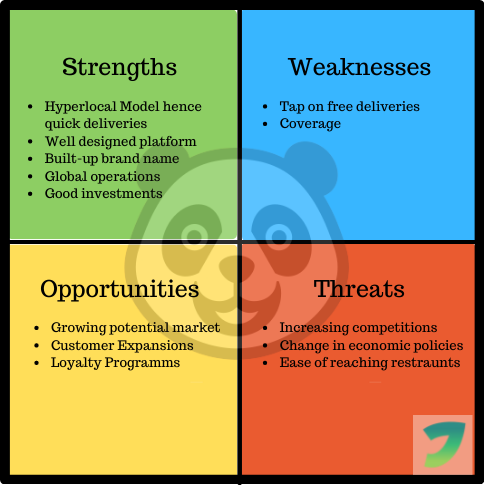
- Hyperlocal Model hence quick deliveries
- Well designed platform
- Built-up brand name
- Global operations
- Good investments
- Tap on free deliveries
Opportunities
- Growing potential market
- Customer Expansions
- Loyalty Programms
- Increasing competitions
- Change in economic policies
- Ease of reaching restraunts
- Development and maintenance cost of its online ordering system. The system comprises Foodpanda’s website, merchant app, customer app, delivery partner app, and the backend setup for managing everything.
- Salaries and provisions for full-time employees.
- Salaries and incentives for distribution partners.
- Administrative costs.
- Customers are given benefits in the form of offers.
- Returns and refunds.
- Miscellaneous expenses.
Online food ordering platforms like Foodpanda, Swiggy, Grubhub, UberEats compete for a long time. To compete with them, choose the right food ordering platform and the best app development company.
Enthusiastic entrepreneurs must capitalize on the current dynamics to give customers what they want; and also commence a thriving startup in the process. To accelerate the growth of this potential sector, Yelo by Jungleworks offers a no-code cloud-based on-demand ordering platform where hyperlocal businesses can offer direct-to-consumer and multi-vendor services to consumers.
Yelo helps you to build a highly efficient and technologically sound hyperlocal ordering platform without the need for coding. You don’t have to create your whole store from scratch, as Yelo offers pre-built modules for all the essential features you need for your business.
It offers inbuilt themes and other pre-created aesthetic elements to help you craft your own brand image. With access to several advanced features such as 100+ payment gateways, 500 integrations , availability in 50+ languages, and many more, you can make your brand highly personalized, thus enhancing their shopping experience.
Start with Yelo’s 14 days free trial now!
To read more about successful business models, follow our resource section .

Know how Yelo can add value to your Business

Subscribe to stay ahead with the latest updates and entrepreneurial insights!
Share this article:

Subscribe to our newsletter
Get access to the latest industry & product insights.
Quickstart Guides

You may be interested in these articles

Jungleworks 9th April 2024
Jungleworks 5th April 2024
Jungleworks 2nd April 2024
Jungleworks 1st April 2024
Find out how Jungleworks' products can help you set up & manage your online business
Have our business experts on the phone to understand your company's operations and guide you through a demo customized to your business industry.

Request a Free Demo
Our experts will contact you shortly
Step 1 of 3.
Explore our platform and launch your business with Yelo
Take a comprehensive walkthrough of the features and functionalities that Yelo provides, and learn how you can launch and grow your hyperlocal business.

Launch your Hyperlocal Business
Get started with Yelo Today
Already have an account, Sign In .
Your Theme has been Selected If you wish to proceed with this, the selected theme will be applied to your live account.
If that's okay, kindly proceed ahead ., sign up for 14 days free trial..
Learn more about Yelo and its features during Yelo's 14 days free trial. You can set up your online hyperlocal store without coding and explore the platform on your own. Upgrade your plan only when you're ready.
Start your 14 days free trial.
Make the best of this opportunity, explore the platform before you pay.
Find out how Panther can help you expand your consultation business.
Build a community of doctors, lawyers, astrologers, fitness experts and many more with Panther. Connect with our business experts & get a demo customized to your business requirements.

Launch Your Consultation Business
Sign up for 14 days free trial.
Learn more about Panther and its features during Panther's 14 days free trial. You can set up your online consultation platform without coding and explore it on your own. Upgrade your plan only when you're ready.
Find out how Yelo can help you expand your business.
Have our business experts on the phone to understand your brand's operations and guide you through a demo customized to your business industry.

Find out how Tookan can help you set up and grow your online delivery & logistics business
Connect with our product specialists to understand how the world's fastest-growing companies use Tookan to optimize deliveries.

Get in Touch
Our business experts will contact you shortly
Explore the Tookan platform for your business and get started today
Take a comprehensive walkthrough of the features and functionalities that Tookan provides, and learn how you can start managing your dispatch and delivery operations in a smoother manner.

Get Started for Free
Your online delivery platform is just one step away
Learn more about Tookan and its features during the 14 days free trial. You can start managing your operations with Tookan without coding. White-label your platform or upgrade your plan only when you're ready.
Our team will get in touch with you for the next steps, For questions or rush request please email [email protected]
Our Product Specialist will get in touch with you for the next steps. Click on the button below to see how your website will look like.
Get your Tech, sorted!

Join us for a live demo!
We'll walk you through the product suite and answer all your questions about Jungleworks.
This web app uses cookies to compile statistic information of our users visits. By continuing to browse the site you are agreeing to our use of cookies. If you wish you may change your preference or read about cookies
Or explore sectors:
Why foodpanda's business model is so successful.

Foodpanda business model canvas
Foodpanda’s Company Overview
Foodpanda GmbH operates an online food ordering marketplace. Its platform enables users to order food online, as well as through mobile applications. The company was founded in 2012 and is headquartered in Berlin, Germany. It has operations in India, Thailand, Indonesia, Pakistan, Singapore, Malaysia, Brunei, Vietnam, Taiwan, Bangladesh, Kazakhstan, Azerbaijan, Hong Kong, the Philippines, the Russian Federation, Ukraine, Hungary, Romania, Bulgaria, Georgia, and Serbia.
Country: Germany
Foundations date: 2012
Type: Subsidiary
Sector: Transportation
Categories: Logistics
Foodpanda’s Customer Needs
Social impact:
Life changing: affiliation/belonging, self-actualization
Emotional: rewards me, provides access, design/aesthetics
Functional: organizes, integrates, variety, simplifies, makes money, reduces cost, reduces risk, connects, reduces effort, avoids hassles, informs, saves time, sensory appeal
Foodpanda’s Related Competitors
Foodpanda’s business operations.
Affiliation:
Commissions are used in the affiliate revenue model example. Essentially, you resell goods from other merchants or businesses on your website or in your physical store. You are then compensated for referring new consumers to the company offering the goods or services. Affiliates often use a pay-per-sale or pay-per-display model. As a result, the business can access a more diversified prospective client base without extra active sales or marketing efforts. Affiliate marketing is a popular internet business strategy with significant potential for growth. When a client purchases via a referral link, the affiliate gets a portion of the transaction's cost.
Brands consortium:
A collection of brands that coexist under the auspices of a parent business. The businesses in this pattern develop, produce, and market equipment. Their strength is in copywriting. Occasionally used to refer to a short-term agreement in which many companies (from the same or other industrial sectors or countries) combine their financial and personnel resources to execute a significant project benefiting all group members.
A brokerage firm's primary responsibility is to serve as a middleman, connecting buyers and sellers to complete transactions. Accordingly, brokerage firms are compensated through commission once a transaction is completed. For example, when a stock trade order is executed, a transaction fee is paid by an investor to repay the brokerage firm for its efforts in completing the transaction.
Codifying a distinctive service capability:
Since their inception, information technology systems have aided in automating corporate operations, increasing productivity, and maximizing efficiency. Now, businesses can take their perfected processes, standardize them, and sell them to other parties. In today's corporate environment, innovation is critical for survival.
Corporate renaissance:
Improving management and performance for companies of all sizes, industries, and globally via creative solutions. Alternate Capital Raising Platform is a novel method of obtaining money that connects the prospective buyer with available capital sources such as venture capital funds, angel investors, and others.
Cross-subsidiary:
When products and goods and products and services are integrated, they form a subsidiary side and a money side, maximizing the overall revenue impact. A subsidiary is a firm owned entirely or in part by another business, referred to as the parent company or holding company. A parent company with subsidiaries is a kind of conglomerate, a corporation that consists of several distinct companies; sometimes, the national or worldwide dispersion of the offices necessitates the establishment of subsidiaries.
Customer loyalty:
Customer loyalty is a very successful business strategy. It entails giving consumers value that extends beyond the product or service itself. It is often provided through incentive-based programs such as member discounts, coupons, birthday discounts, and points. Today, most businesses have some kind of incentive-based programs, such as American Airlines, which rewards customers with points for each trip they take with them.
Discount club:
The discount club concept is built on perpetual high-discount deals utilized as a continual marketing plan or a brief period (usually one day). This might be seen as a reduction in the face value of an invoice prepared in advance of its payments in the medium or long term.
Disruptive trends:
A disruptive technology supplants an existing technology and fundamentally alters an industry or a game-changing innovation that establishes an altogether new industry. Disruptive innovation is defined as an invention that shows a new market and value network and ultimately disrupts an established market and value network, replacing incumbent market-leading companies, products, and alliances.
Dynamic branding:
Dynamic branding is a technique for refreshing your identity without totally altering it. You can link to anything; you may modify the logo according to the seasons or for a particular event. It has been proven effective many times. However, it does not work for every business.
Electronic commerce, or e-commerce (alternatively spelled eCommerce), is a business model, or a subset of a larger business model, that allows a company or person to do business via an electronic network, usually the internet. As a result, customers gain from increased accessibility and convenience, while the business benefits from integrating sales and distribution with other internal operations. Electronic commerce is prevalent throughout all four main market segments: business to business, business to consumer, consumer to consumer, and consumer to business. Ecommerce may be used to sell almost any goods or service, from books and music to financial services and airline tickets.
Ingredient branding:
Ingredient branding is a kind of marketing in which a component or ingredient of a product or service is elevated to prominence and given its own identity. It is the process of developing a brand for an element or component of a product in order to communicate the ingredient's superior quality or performance. For example, everybody is aware of the now-famous Intel Inside and its subsequent success.
Lean Start-up:
The Lean Start-up methodology is a scientific approach to developing and managing businesses that focuses on getting the desired product into consumers' hands as quickly as possible. The Lean Startup method coaches you on how to guide a startup?when to turn, when to persevere?and how to build a company with maximum acceleration. It is a guiding philosophy for new product development.
Mobile first behavior:
It is intended to mean that as a company thinks about its website or its other digital means of communications, it should be thinking critically about the mobile experience and how customers and employees will interact with it from their many devices. The term is “mobile first,” and it is intended to mean that as a company thinks about its website or its other digital means of communications, it should be thinking critically about the mobile experience and how customers and employees will interact with it from their many devices.
New job trends:
The workforce as a whole is gravitating toward remote, dispersed teams comprised of freelancers and independent contractors. Workplace customization extends beyond IT and gadgets; workflow, behavior, and expectations are modeled after real-world applications. These are novel methods of job search.
On-demand economy:
The on-demand economy is described as economic activity generated by digital marketplaces that meet customer demand for products and services via quick access and accessible supply. The supply chain is managed via a highly efficient, intuitive digital mesh built on top of current infrastructure networks. The on-demand economy is transforming commercial behavior in cities worldwide. The number of businesses, the categories covered, and the industry's growth rate are all increasing. Businesses in this new economy are the culmination of years of technological progress and customer behavior change.
Online marketplace:
An online marketplace (or online e-commerce marketplace) is a kind of e-commerce website in which product or service information is supplied by various third parties or, in some instances, the brand itself, while the marketplace operator handles transactions. Additionally, this pattern encompasses peer-to-peer (P2P) e-commerce between businesses or people. By and large, since marketplaces aggregate goods from a diverse range of suppliers, the variety and availability are typically greater than in vendor-specific online retail shops. Additionally, pricing might be more competitive.
Referral marketing is a technique for acquiring new consumers by advertising goods or services through recommendations or ordinary word of mouth. While these recommendations often occur spontaneously, companies may influence this via the use of suitable tactics. Referral marketing is a technique for increasing referrals through word of mouth, arguably the oldest and most trusted kind of marketing. This may be done by incentivizing and rewarding consumers. A diverse range of other contacts to suggest goods and services from consumer and business-to-business companies, both online and offline.
Self-service:
A retail business model in which consumers self-serve the goods they want to buy. Self-service business concepts include self-service food buffets, self-service petrol stations, and self-service markets. Self-service is available through phone, online, and email to automate customer support interactions. Self-service Software and self-service applications (for example, online banking apps, shopping portals, and self-service check-in at airports) are becoming more prevalent.
Sharing economy:
The sharing economy eliminates the necessity for individual asset ownership. The phrase sharing economy is an umbrella word that encompasses various definitions and is often used to refer to economic and social activity that involves online transactions. Originally coined by the open-source community to refer to peer-to-peer sharing of access to goods and services, the term is now occasionally used more broadly to refer to any sales transaction conducted via online marketplaces, including those that are business to consumer (B2C) than peer-to-peer.
Subscription:
Subscription business models are built on the concept of providing a product or service in exchange for recurring subscription income on a monthly or annual basis. As a result, they place a higher premium on client retention than on customer acquisition. Subscription business models, in essence, concentrate on revenue generation in such a manner that a single client makes repeated payments for extended access to a product or service. Cable television, internet providers, software suppliers, websites (e.g., blogs), business solutions providers, and financial services companies utilize this approach, as do conventional newspapers, periodicals, and academic publications.
Take the wheel:
Historically, the fundamental principles for generating and extracting economic value were rigorous. Businesses attempted to implement the same business concepts more effectively than their rivals. New sources of sustained competitive advantage are often only accessible via business model reinvention driven by disruptive innovation rather than incremental change or continuous improvement.
Technology trends:
New technologies that are now being created or produced in the next five to ten years will significantly change the economic and social landscape. These include but are not limited to information technology, wireless data transmission, human-machine connection, on-demand printing, biotechnology, and sophisticated robotics.
Transaction facilitator:
The business acts as an acquirer, processing payments on behalf of online merchants, auction sites, and other commercial users for a fee. This encompasses all elements of purchasing, selling, and exchanging currencies at current or predetermined exchange rates. By far the biggest market in the world in terms of trade volume. The largest multinational banks are the leading players in this industry. Around the globe, financial hubs serve as anchors for trade between a diverse range of various kinds of buyers and sellers 24 hours a day, save on weekends.
Two-sided market:
Two-sided marketplaces, also called two-sided networks, are commercial platforms featuring two different user groups that mutually profit from the web. A multi-sided platform is an organization that generates value mainly via the facilitation of direct contacts between two (or more) distinct kinds of connected consumers (MSP). A two-sided market enables interactions between many interdependent consumer groups. The platform's value grows as more groups or individual members of each group use it. For example, eBay is a marketplace that links buyers and sellers. Google connects advertising and searchers. Social media platforms such as Twitter and Facebook are also bidirectional, linking consumers and marketers.
Uberization:
Uberization is a phrase that refers to a shift to an operational paradigm that allows economic actors to trade underused capacity of existing assets or human resources at near-zero transaction costs. The word Uberization is taken from the company's name. Thus, the model's operational expenses are distinct from those of an established company.
Embed code:
Recommended companies based on your search:
Deliveroo Business Model
Just eat business model, delivery hero business model.
Vizologi is a platform powered by artificial intelligence that searches, analyzes and visualizes the world’s collective business model intelligence to help answer strategic questions, it combines the simplicity of business model canvas with the innovation power of mash-up method .
See how Vizologi works View all features
You rock! Thank you for your interest. Before starting the canvas download, we would like to ask you to pay with a tweet.
Download paying with a tweet
Supercharge Your Business Strategy!
Before you download our exclusive content Subscribe to Vizologi’s FREE newsletter. Join 50k+ innovators shaping success with curated content. No spam, just pure value! @vizologi

Thanks for joining us!
Your exclusive content is on the way to your inbox. Ready to elevate your business with Vizologi?
- Data Engineering
- Machine Learning
- RESTful API
- React Native
- Elasticsearch
- Ruby on Rails

Foodpanda Business Model: How Foodpanda Works & Makes Money
Online food delivery platform, Foodpanda connects users to thousands of local meal ordering and delivery points. The hyperlocal delivery-based business model helps the delivery giant to cater to the growing demand in the market. Looking at the business giant's success, many delivery brands are interested in a Foodpanda business model; they are trying to know how the delivery platform works and makes money.
The food delivery giant has covered a long journey. We are serving the communities in more than 400 cities and more than 12 markets in Asia, and the company hopes to play a positive part in customers' lives.
Foodpanda is Asia's largest delivery platform that helps 3000 new retailers and stores. The SMEs' digitization made them experience 430% of growth. It is the most used platform for ordering meals from restaurants.
Users can explore multiple options before placing the order; they can even choose between pick-up or home delivery at their convenience. It takes only a few minutes for customers to place an order; Foodpanda offers customer ratings, menus, and other details for over 12 countries and over 115000+ restaurants.
What is Foodpanda?
Owned by Delivery Hero, Foodpanda is an on-demand food and grocery delivery platform. The company operates as a lead brand that is headquartered in Singapore and works for Delivery Hero in Asia.
Recently Foodpanda invited panda pro members to a get-together event; guests had a great chance to build magical connections, go around the venue, and bond over their mutual love for meals while dining in style.
History and Successtime of Foodpanda to Look into!
Foodpanda is a leading food delivery operator that has completed millions of orders till today and raised more than 8.7 million. The meal delivery sector in the Philippines has been dominated by two companies, Foodpanda and Grab. These companies will cover around 52% and 48% of the market share, respectively, in 2021. Meal delivery is a growing sector worldwide, mainly since the pandemic spread.
Online food ordering and delivery platforms serve in many areas like Bangladesh, Hong Kong, Cambodia, Hungary, Germany, Japan, Laos, and many more. Foodpanda processes and delivers orders directly to local restaurants, the delivery agent then delivers the food to the customers' location. Customers can book the meal through a website and mobile app on iOS and android platforms. Have a look at the success timeline before exploring the Foodpanda business model right here.
Foodpanda enables customers to browse the menu, select items, enter a delivery location, and make payments online/offline. They can even use the review section on restaurant sites to leave comments on delivery, taste, and sales and rate the local store based on an overall impression of the restaurant.
Foodpanda gobbled up $20 million in initial funding from Phenomen Ventures, Rocket Internet, and Investment AB Kinnevik in April 2013. Later, iMENA Holdings invested around $8 million in September 2013. There was another funding round of $20 million in February 2014 from a group of investors and Phenomen Ventures.
In August 2014, Foodpanda announced that it collected $60 million in financing from a group of investors. The food delivery giant raised another $110 million from Rocket Internet and other investors in March 2015. Two months later, Goldman Sachs, along with other investors, invested about $100 million.
Delivery Hero acquired Foodpanda in December 2016. You might have a clear idea about Foodpanda funding, investment, acquisition, and success time. Now let's explore how Foodpanda works, and it's business and revenue model right here.
Foodpanda Business Model: How Delivery Giant Satisfy Growing Demand?
Foodpanda workflow is based on the hyperlocal business model, which provides numerous benefits to the company. The top benefits of the Foodpanda business model are as follows:
- Helps to meet the growing demand for hyperlocal online meal delivery services
- User engagement
- Improved business control
- Supporting local restaurants
Foodpanda maintains a website and app that food lovers can use to order food from their favorite restaurants and eateries. In 2018, Foodpanda started providing special deals, offers, and discounts to increase platform traffic. The company has clocked around 30,000 to 35,000 orders per day before the approach. This number is expected to reach 5,000 daily orders in the future.
The delivery company continues in-house brands known as "cloud kitchens." This concept was adopted by the delivery giant when it acquired Holachef. However, the company has three private-label brands in 2019 under its cloud kitchen business, including the FLRT and Great Khichdi experiment.
Customer Segments Multi-sided Foodpanda business model has two interdependent customer segments possessing its essential; this segment includes:
• Restaurant; • Customers; • Delivery agents.
Value Proposition The platform provides value propositions including cost reduction, brand status, accessibilities, convenience, and customization. Foodpanda develops accessibilities by permitting meal stores to promote their business to customers who want to visit a physical location and search for tribulation by searching the website online.
It allows customers to place orders from an online food ordering app or website, providing great convenience. They can get round-the-clock service from the delivery providers without any hassle. Customers can choose to pick up or get meals delivered right to their doorsteps.
The platform allows customers to filter restaurants as per their type. It also provides lots of engaging deals to customers, such as meal discounts, free deliveries, and more. Amazing offers boost customer engagement and encourage them to try something new and save their cost.
Cost Structure Foodpanda has built a strong brand with its effective business model. The delivery giant serves more than 500 cities in around 24 countries. An online ordering and meal delivery platform won the European Tech Startup Award in 2014 for "Best E-commerce Startup."
The amazing cost-driven structure aims to minimize expense, boost significant automation, and surge store sales. However, the biggest cost drivers for the food delivery platform are advertising costs, employees' salaries, etc. Few other drivers are like administration, customer support, etc.
How Does Foodpanda Work?
Effective Foodpanda business model provides great convenience to all the users. Customers can follow the easy registration and login process to use the platform. They can browse the nearby restaurant and their menu to place an order from them. Once they finalize the order, they can move to the check-out process and pay using multiple payment options like credit/debit cards or other payment options.
Once the customer places the order, the restaurant gets notified about the same. Then, the Foodpanda partner restaurant confirms the order and prepares the meal. As soon as the order is prepared, the restaurant requests a delivery provider to deliver the meal to the customer's place.
The delivery agent then collects the order and delivers it to the customer's place. The customer is allowed to track the process right from the moment the restaurant accepts their request through the delivery website and app. They can review and rate the restaurant and delivery provider as per their experience.
Many food ordering and delivery business entrepreneurs are getting inspired by a Foodpanda business model and the way it works to satisfy customers' growing requirements and investing in an app similar to Foodpanda. If you are also looking for a meal ordering and delivery app development service, White Label Fox can help you with it. Contact our experts to get a free quote right away.
Foodpanda Revenue Model: How it Makes money?
Most revenue of Foodpanda comes from restaurant commissions with which the delivery giant has partnered. Besides, it also generates revenue from other sources helping the company to generate great profits. The food ordering and delivery market generated around US$7.4 billion in 2021; this profit increased by 40% year-on-year.
Foodpanda segment revenue increased by 60% due to the COVID-19 pandemic; the revenue increased by US$616.2 million in the same quarter a year ago. Foodpanda has seen a great increase in revenue in recent years. The company generates revenue through various means like commission, advertisement, etc.
Restaurant Registration Fees Restaurants have to pay registration fees to register themselves with the Foodpanda website and app. Customers looking to satisfy their cravings can find eateries on the Foodpanda platform. The registration charges are between $100 to $150. It is a one-time payment for restaurants helping them to generate great profits.
Commission Restaurants have to pay a commission to Foodpanda for each order they get through the platform. They have to pay between 15 to 25% to Foodpanda with all taxes. The commission is determined based on the restaurant's location and also on the volume and kind of orders the restaurant receives on the platform.
Delivery Fees Every order customers place through the Foodpanda platform is subject to delivery fees. This delivery charge depends on the distance that needs to travel between customers and the restaurant's location.
Advertisement Many business entrepreneurs use Foodpanda as an advertising platform as it helps them boost their visibility. Businesses have to pay a steady fee to advertise their brand on this food ordering and delivery platform.
Affiliate Earnings The delivery giant makes money by making recommendations on different credit cards. It stimulates transactions; banks provide special deals and discounts on their cards. You can also use affiliate marketing to earn money like Foodpanda.
A food delivery app like Foodpanda has competed with many delivery giants and made its name in today's competitive market. If you want to grab similar success, then you need to choose the right tech partner. Capitalizing on the dynamic method can help you provide your customers with what they are looking for.
Ending Note
Foodpanda has faced lots of ups and downs and has survived due to its effective business model. If you want to achieve similar success, then following the Foodpanda business model is the best option. We hope this blog might help you to know how Foodpanda works and makes money.
If you want to capture a vast base, then developing a delivery anything app is a smart choice to make. White Label Fox can help you give an online touch to your delivery business, get in touch to know how we help give a digital touch to your business and contact us at: [email protected].
Enjoy this post? Give Smith Joe a like if it's helpful.
Leave a like and comment for Smith
Foodpanda’s journey is a remarkable example of innovation and growth in the online food delivery industry. Their success story, mirroring the dynamic Foodpanda business model, is an inspiration for many in the sector, including upcoming platforms like https://www.petpediapro.com/ . Their ability to adapt and excel, especially in meeting the diverse needs of customers across Asia, sets a benchmark for others to follow.
The customer support service provided by Personal Loans in Alaska is also commendable. Their friendly and knowledgeable staff is immediately available to answer any questions or concerns you may have about the loan process. Whether you need clarification regarding loan terms, repayment options or any other aspect, their Personal Loans In Alaska team is dedicated to providing you with a seamless experience. This enables you to make informed decisions and avoid any unexpected surprises.
- On-Demand Delivery Solution
- Small Business
The Food Delivery Business Model – A Comprehensive Guide
Table of Contents Hide
Starting an online meal delivery service, a. aggregator business model, b. inventory model, how to differentiate between food delivery business models, moving forward: want to build your own food delivery business.
Fast, efficient meal ordering and online food delivery services have been in high demand since the global pandemic. Startup entrepreneurs and enterprise companies have and must further capitalize on the modern-day food delivery business model.
As customers want on-the-go meals in minutes, the food delivery business model is the most promising venture. Since most people order meals online, whether they reside in various cities, work late, or are spread out, it is a great time to start a food delivery service and make business profits.
The revenue in the Online Food Delivery Marketplace is projected to reach US$ 1.02tn by the end of the year 2023 .
It is further projected to exhibit a compound annual growth rate (CAGR 2023-2027) of 12.78 percent , leading to an expected market volume of around US$ 1.65tn by the year 2027.
However, customers will only accept your business model once you offer high-quality food at a fair price and enable timely meal delivery to satisfy their hunger and build trust in your on-demand services. Pulling this off needs a tight Food Delivery Business Plan and cutting-edge tech gear.
Commencing an online meal delivery service has its own benefits and business challenges. This thorough guide covers everything from creating a food delivery business strategy to setting up your digital delivery network.
This comprehensive guide also explores the overall turnaround times, strategies, and tactics to draw more customers to your online food delivery business . Those planning or starting a meal delivery business should definitely read this blog post.
How a subscription-based food delivery business is the latest trend in India?
Diverse Categories of Food Delivery Business Models
In the food delivery industry, having a user-friendly mobile app, dependable delivery services, and happy clients are all expected. However, the business model you select will act as the basis for how your firm will function and earn income daily. There are three distinct food delivery options available today.
However, keep in mind that the vast majority of online meal delivery services use the marketplace business model. In this article, we will examine the various business plans for meal delivery services. It is important to weigh the benefits and drawbacks of each option as a beginning food delivery app business model.
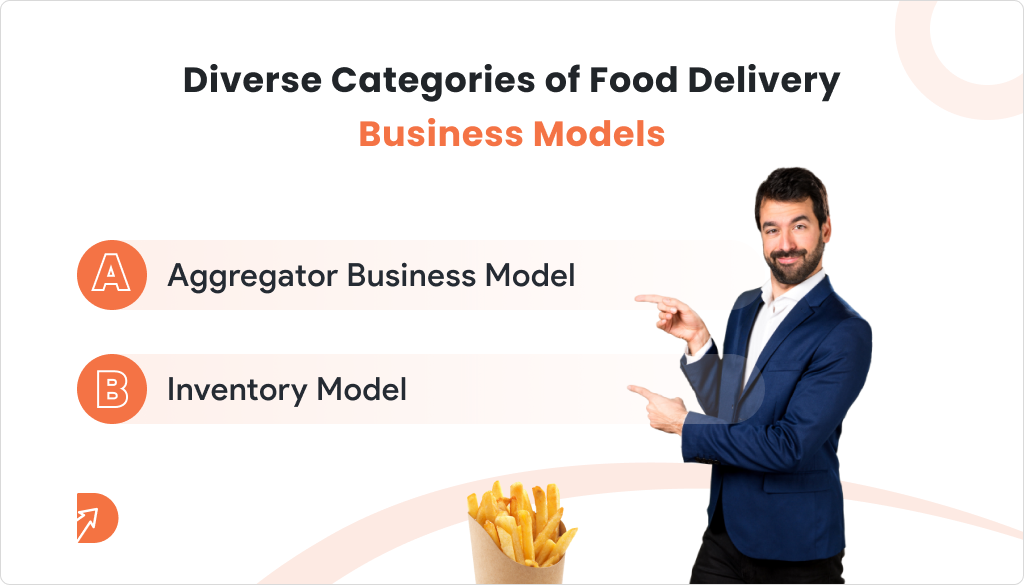
The one that aggregates, as the name implies. Thus, under this paradigm, customers can view restaurant menus and order from the one they like. They may order food and usually have the app delivered. So, it is a customer-restaurant communication relationship.
This aggregator mediates between clients and local restaurants; therefore, you could call it a mediator. A web page or smartphone app gives you access to several cuisines. Order support is an aggregator’s main role. How does the food delivery app work?
After enrolling into an app or website, users may compare pricing, menus, ratings, and reviews and place orders. After the consumer confirms, the aggregator sends the order to the restaurant. This is one of the most popular food delivery services.
Foodpanda Business Model: How Does Foodpanda Make Money?
Then, the eatery delivers. Aggregators receive a predetermined fee for orders placed through their service. Usually, participating eateries pay this fee without charging consumers. The US-based large players Delivery Hero, FoodPanda, Grubhub, and UberEats have achieved global success in this field and offer their services worldwide.
Interested in Creating a Clone for a Food Delivery App? Explore this:
- Order and Delivery Model:
New restaurant markets are emerging with the primary goal of increasing the number of orders and requests made to restaurants by linking them with a network of independent couriers or delivery applications.
The menu of a restaurant is uploaded to the app or online interface where orders are placed. To cover the cost of the online food delivery business commission, some restaurants add a markup to the pricing of the goods on the menu. The clients are also paid a set price for every restaurant where you place an order. The order is routed to the distribution center that is most conveniently located for the customer to pick it up.
When a delivery partner is working, they must use a special phone app that can always monitor their whereabouts. The distribution center evaluates orders it receives and chooses whether to fulfill them. Whoever claims the position first gets it. If no one volunteers, it will be transferred to other delivery hubs, which may be farther away or refused.
With each shipment, they gain valuable information to continually enhance their technological advantage by determining the most efficient routes and most effective pick-up and delivery schedules. Businesses based on this model have employees whose job is to transport prepared meals from the kitchen to the various pick-up points.
The Key Benefits of the Order and Delivery Model
The restaurants and delivery guys’ ability to provide a positive user experience is crucial to the success of this food delivery business model canvas . The restaurants might be charged a flat commission rate for each order, and the consumers can be charged a delivery fee if the order total is low or the delivery address is far away.
Training delivery boys allows you to provide your consumers with both a flexible and rapid delivery option. This will enable you to achieve higher ratings for your food delivery business . Here, all you have to do is keep an eye on what’s happening concerning your company and fix problems if you encounter them.
Some Challenges in Order and Delivery Model
The timely arrival of the order is the primary logistical obstacle here. Most consumers are concerned about when they will receive their food, so you should investigate options for timely delivery. Due to the nature of the working day, lunch orders must arrive on time. Here, resource management becomes an additional obstacle.
- Integrated Model:
The integrated food delivery strategy is highly adaptable and widely sought after. In this setup, both the administration and the restaurants can handle the delivery duties.
Many eateries already have their teams of delivery people; all they need is a way to get their food and drinks online. The integrated concept allows online meal ordering platforms to accommodate these eateries readily.
For the admin to quickly observe if the delivery is managed by the restaurant or himself, the chosen food delivery app solution should allow restaurants to request permission from the admin before setting delivery services to “Self.” When a user places an order with a restaurant, the platform’s admin sees if the restaurant is set up for self-delivery or uses the platform’s delivery services.
Meal delivery company plans commonly allocate orders in two ways. First, the order is sent immediately to the nearest driver without admin participation. The second one involves admin order allocation.
Customer orders go to the admin panel, where the admin assigns them to the nearest driver. Company-employed drivers deliver food here. Customers can choose between scheduled or quick delivery. Every driver receives meals to deliver to customers.
The Key Benefits of the Integrated Model
The platform owner can weather the storm of beginning a new business with this business model of food delivery . The integrated strategy lets restaurants distribute food without a fleet. This firm structure allows more restaurants to join the network, providing users with more culinary and eating alternatives.
Some Challenges in Integrated Model
The high cost of operation is the major problem for this type of meal delivery service. Due to high overhead, many new companies that provide food delivery are forced to close their doors.
This was especially true of individuals who attempted to prepare their meals. To avoid such a loss, businesses can experiment with simultaneous multiple delivery attempts and focus on improving the customer experience.
Deliveroo Business & Revenue Model: How Does it Work and Make Money?
The online food delivery service business plan has a fully internalized inventory approach. Only one party is concerned. Everything associated with introducing the food delivery website/app, including the preparation of orders and their delivery to clients, is handled by the food delivery company. The value chain is under the sole management of the platform owner.
The nature of the meal delivery industry does not lend itself to having several eateries advertise their offerings through a common channel. A contracted courier service handles order delivery after it has been prepared at the company’s central kitchen. This showcases the business owner’s aptitude to track the quality and excellence of the food being delivered precisely.
Chain restaurant business models like Domino’s Pizza, McDonald’s, and Burger King frequently use the inventory approach. So, the inventory model is the way to go if you operate a restaurant chain and want to expand your business online through a website or app.
The Key Benefits of the Inventory Model
The primary benefit of the stockpile approach is that it eliminates the need for a separate food delivery system. Businesses with multiple locations in a single city, each with its delivery fleet and an interest in expanding their online presence, may consider the inventory model.
To accommodate clients who would like to place online orders from their restaurants, these companies can create a website or a meal delivery platform. By doing so, companies can avoid the commission paid to the third-party platform and have complete control over defining the whole consumer experience.
Some Challenges in the Inventory Model
Businesses that rely on an inventory model to distribute food have a significant disadvantage in the form of high operational costs. The culinary staff may also need help to meet the needs of both takeaway and dine-in customers. The right meal delivery software should let the owner coordinate activities in both the virtual and physical worlds.
Avoid mixing the three models. Model 1 will have a restaurant with a delivery boy. Delivery drivers, eateries, and app owners will work alone in the second model.
It will be delivered from the restaurant to the customer. App owners will get a part of the business model’s revenue. The owner of the third model will manage a restaurant and delivery service. Everything from cooking to delivering is your job here.
The food delivery revenue model platform makes app authors more money. It is easy to charge restaurant partners a flat price to handle app orders, making this a good meal delivery business strategy. Customers may also pay location-based delivery fees.
This business strategy eliminates logistics; thus, some restaurants prefer it. Here, the app owner oversees all delivery services.
Thus, eateries only need to prepare their cuisine, while a third party handles the rest. As shown above, all three meal delivery business models have merits and cons. Study your business idea and pick the ideal one for your new food delivery business. However, you must collaborate with a successful mobile app development company.
This helps you determine the best business plan, especially if you have a trustworthy food delivery app development firm to help you stand out.
Consider designing a meal delivery app with easy navigation and user interface. Thus, you must follow all the requirements of the on-demand food delivery service and build the best food delivery apps.
You can hire an experienced mobile app development company for your food delivery business. This gives your app a smooth UI and UX that improves usability, letting you choose your favorite food delivery app business model. Consider consumer convenience, alignment with your company’s goals, and technical developments before choosing a Food Delivery Business Plan and meal delivery service.
However, designing and developing a precise mobile application can be somewhat challenging for new startups and small-sized businesses since they have inadequate technology resources to allot to every process, and app development calls for heavy financial investments both in minds and machines.
Do not worry, as DeOnDe is here to back such business ventures with profitability. So, if you are looking for a SaaS-based food delivery app solution , our teams at DeOnDe can provide you the best readymade food delivery business solutions and offer a result-oriented application particularly created for your dedicated food ordering and delivery business.
For more technology details and business insights, visit www.deonde.co and register for a free online demo.

Leave a Reply Cancel reply
Your email address will not be published. Required fields are marked *
Related Posts
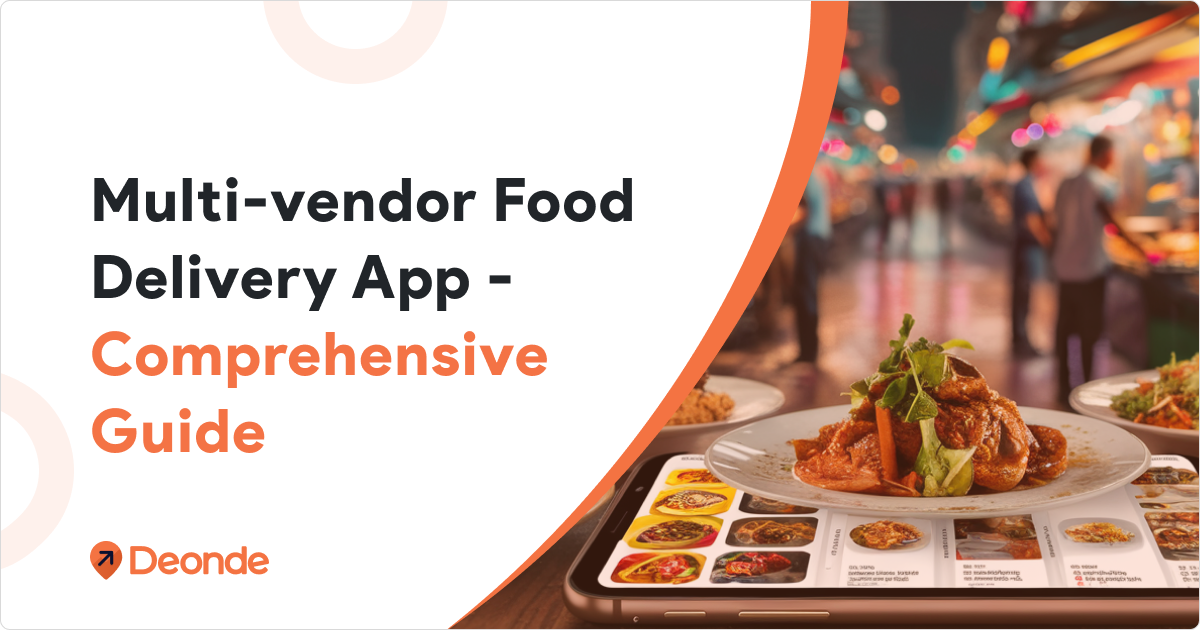
- How-To-Guides
- Marketplace
Multi-vendor Food Delivery App -Comprehensive Guide
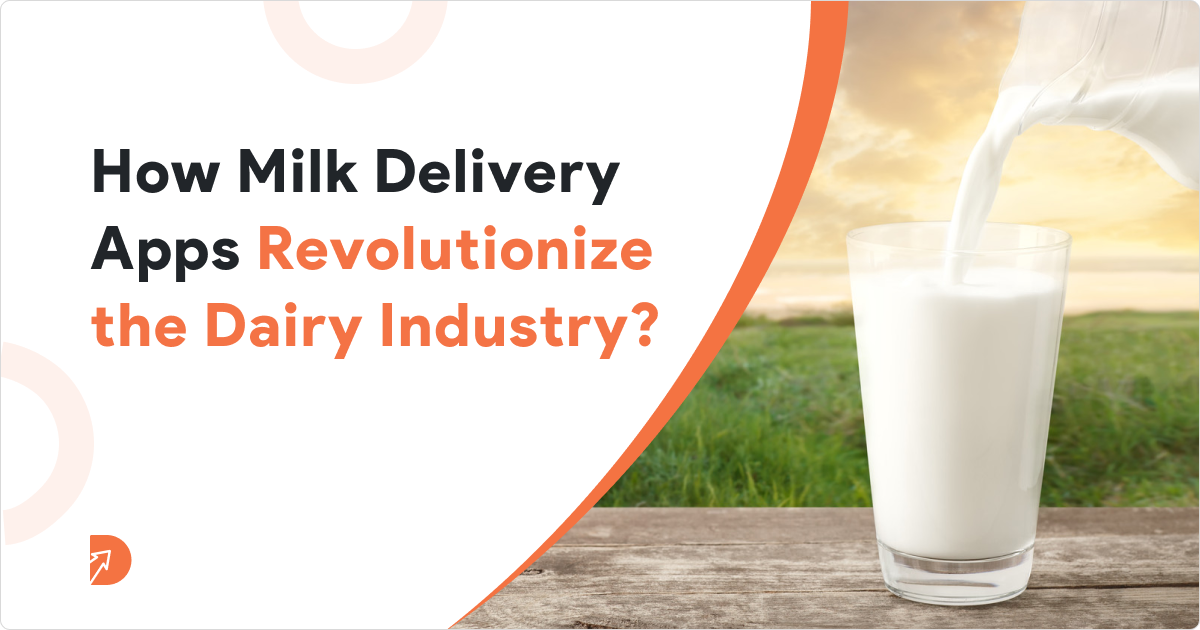
- Tips & Tricks
How Milk Delivery Apps Revolutionize the Dairy Industry?
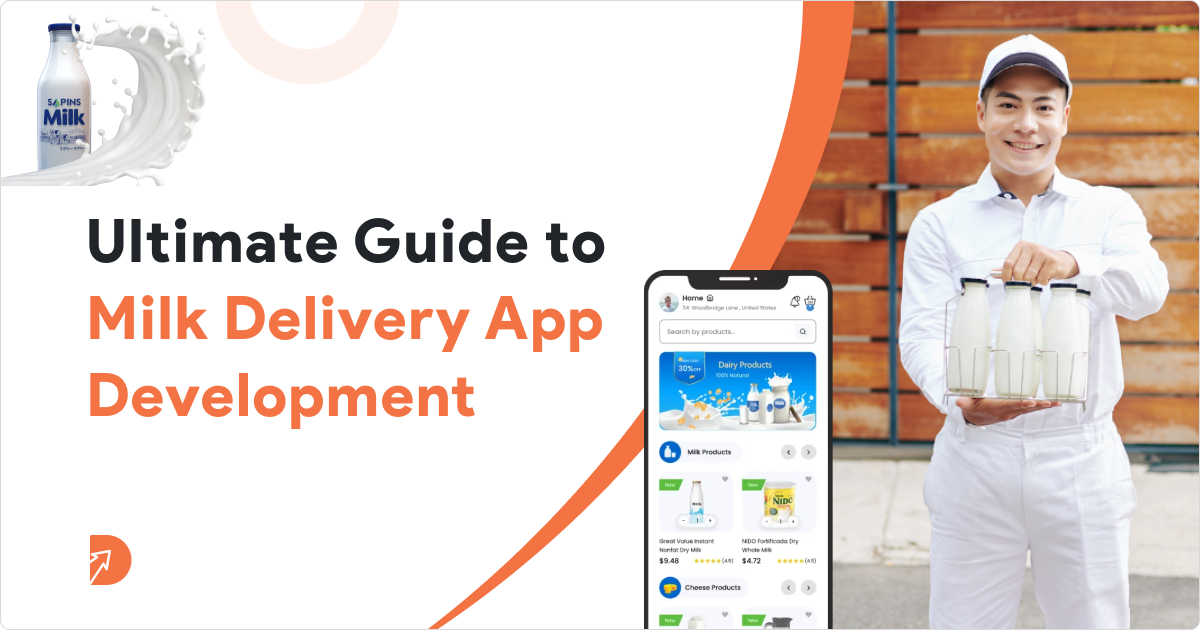
A Step-by-Step Guide to Milk Delivery App Development for Dairy Business
Ready to grow your business?
Foodpanda brings new opportunities.

Connect With New Customers

Unlock Revenue

Focus on Your Business
We make it simple and easy.

The Customer Orders

You Prepare

Watch Your Business Grow

Any questions?
How do i get started, why should my restaurant partner with foodpanda, how far do you deliver, how does a partnership with foodpanda work, can i stop orders if it gets too busy.

COMMENTS
Aug 29, 2023 — 9 min read. Foodpanda Business Model. Foodpanda is an online food delivery marketplace that connects users to thousands of local food points. It maintains one of the most prominent apps for ordering from restaurants. Users can browse through various menus and place orders for home delivery/pick-up at the best prices.
Executive Summary: Foodpanda is an on-demand delivery platform that delivers meals, beverages, groceries, and more. It partners with independent drivers to fulfill orders. Foodpanda makes money via commissions, delivery fees, subscription fees, as well as grocery sales. The company operates on a marketplace business model.
The business model canvas is a strategic tool used to analyze and plan the various components of a business model. Here is an explanation of the key elements of the Foodpanda business model canvas: Customer Segments: Foodpanda targets two main customer segments: consumers who want to order food online for home delivery and restaurants that want ...
Suppose you are opening a new restaurant as a business startup. You need a place to advertise your business. Foodpanda provides you with a place to do the same. You can advertise your food business on the app. You need to pay a certain advertising fee to the app. This way also makes Foodpanda open to revenues.
Step 1: Food lovers explore the list of nearby restaurants and menus to order mouth-watering dishes from them. Step 2: Restaurants receive an order and prepare food. Step 3: Prepared order is handed over to delivery providers. Step 4: The delivery provider delivers the meals to the customer's place.
Foodpanda is a leading food delivery operator that has completed millions of orders till today and raised more than 8.7 million. The meal delivery sector in the Philippines has been dominated by two companies, Foodpanda and Grab. These companies will cover around 52% and 48% of the market share, respectively, in 2021.
In this episode of The Venture, we share a conversation with Jakob Angele, CEO of foodpanda APAC, the Asia-Pacific business of foodpanda, part of Delivery Hero's global network of food-delivery services.Angele sat down with McKinsey's Andrew Roth to reflect on building a business based on delivering a restaurant meal to someone's home, which at the time of foodpanda's founding was ...
Foodpanda's business model entails maintaining a robust common platform between two parties: consumers and restaurants. Key Partners . Foodpanda does not have a formal partner program. However, it sometimes forms partnerships with similar services to expand its reach. For example, in 2014 it launched a joint venture with OpenRice to increase ...
5| Find opportunity in crisis. The need to adapt is both a curse and a blessing. It can disrupt operations, but it can also push you to be even more innovative and ambitious to survive. In 2020, Foodpanda hit its 100 cities mark as it expanded aggressively throughout the country during the pandemic.
Foodpanda revenue generation. Foodpanda has a typical revenue generation strategy for a food delivery business.The company utilizes the marketplace business model, matching riders and restaurants with customer demand.. A more detailed look at revenue generation is provided below.. Commissions. Foodpanda makes most of its money through restaurant commissions.
Before we dive deep into the PESTEL analysis, let's get the business overview of Foodpanda. Foodpanda is an online food and grocery delivery service that connects people with the best in their cities. The company operates in multiple countries, primarily in Asia and Eastern Europe. In 2016, Delivery Hero, a leading global online food ordering ...
Foodpanda Business Model. Foodpanda's total revenue segment in 2021 was $997.8 million, an increase of almost 62% compared to the previous year. Foodpanda affirms its commitment to its customers by Bringing good food into your everyday. Foodpanda works on bringing customers their favorite food from the restaurants listed on its platform.
Foodpanda is an online food delivery platform that connects users to thousands of local food points i.e catering to the hyperlocal delivery model. It is one of the most widely used apps for ordering food from restaurants. Users can choose from a variety of menus and place orders for home delivery or pick-up at the most competitive prices.
to take her family's business online when foodpanda introduced the #SupportSME initiative to help local businesses digitalise their operations. foodpanda guided Ms Krisdapong on the setting up of her operations on the platform, providing instructions on how to use the tablet to manage the online ordering and payment systems. Since joining
Vizologi is a platform powered by artificial intelligence that searches, analyzes and visualizes the world's collective business model intelligence to help answer strategic questions, it combines the simplicity of business model canvas with the innovation power of mash-up method. See how Vizologi works View all features.
Published Aug 17, 2022. Online food delivery platform, Foodpanda connects users to thousands of local meal ordering and delivery points. The hyperlocal delivery-based business model helps the delivery giant to cater to the growing demand in the market. Looking at the business giant's success, many delivery brands are interested in a Foodpanda ...
Beyond Singapore, more than 6,000 restaurant partners across the region offer vegan and vegetarian options on the platform while foodpanda shops carry over 25,000 sustainable products including plant based meat, in partnership with local retailers, small and medium enterprises (SMEs) and specialty stores. pandamart, foodpanda's cloud-grocery ...
Business foodpanda launches pandapurpose 2022. Share. Recent News . Business Merchants panda ads foodpanda Delivery & Retail Trends 2023. 28 Feb 2024. Business foodpanda, CTBC Bank launch co-branded credit card. 19 Dec 2023. Business foodpanda partners Pine Labs' Qwikcilver to launch gift cards. 14 Dec 2023. Navigate. Home; About;
The Food Delivery Business Model - A Comprehensive Guide. Ashish Sudra. November 29, 2023. Fast, efficient meal ordering and online food delivery services have been in high demand since the global pandemic. Startup entrepreneurs and enterprise companies have and must further capitalize on the modern-day food delivery business model.
Step 1: Submit your restaurant information hereStep 2: we will review your application requestStep 3: Upload document such as your ID Card, Menu, Business License, Bank Account StatementsStep 4: Fill up the contract via the link in the email to complete your registration.
Foodpanda Business Plan Analysis. Dec 21, 2021 • Download as PPTX, PDF •. 1 like • 956 views. AI-enhanced title. M. Maher Awais.
Foodpanda is an online delivery platform for food and groceries operated by Delivery. Hero. Foodpanda is Delivery Hero's primary br and in Asia, having its headquarters in Singapore. It is ...
Business Press foodpanda announces nationwide coverage in Thailand — the first food delivery platform to operate across all 77 provinces. 11 Nov 2020. Business Merchants Press foodpanda grows q-commerce with more than 2,500 7-Eleven stores across Singapore, Malaysia, Taiwan and the Philippines.
1. Executive summary. This short section introduces the business plan as a whole to the people who will be reading it, including investors, lenders, or other members of your team. Start with a sentence or two about your business, development goals, and why it will succeed. If you are seeking funding, summarise the basics of the financial plan. 2.
Business foodpanda Delivery & Retail Trends 2023. Share. Recent News . panda ads Press foodpanda and The Trade Desk partner up to provide brands with data-driven retail media solutions. 23 Apr 2024. Business foodpanda, CTBC Bank launch co-branded credit card. 19 Dec 2023. Business